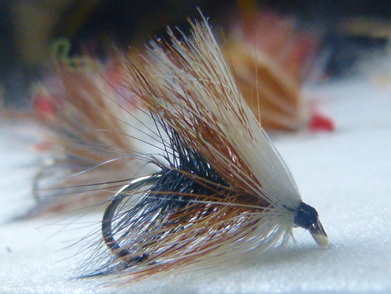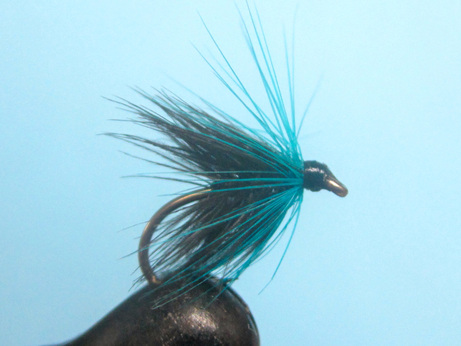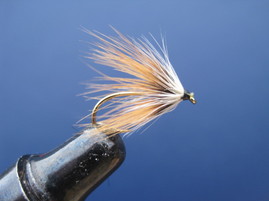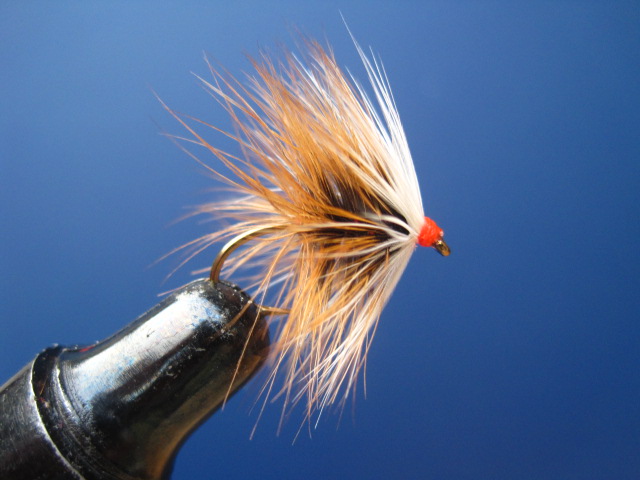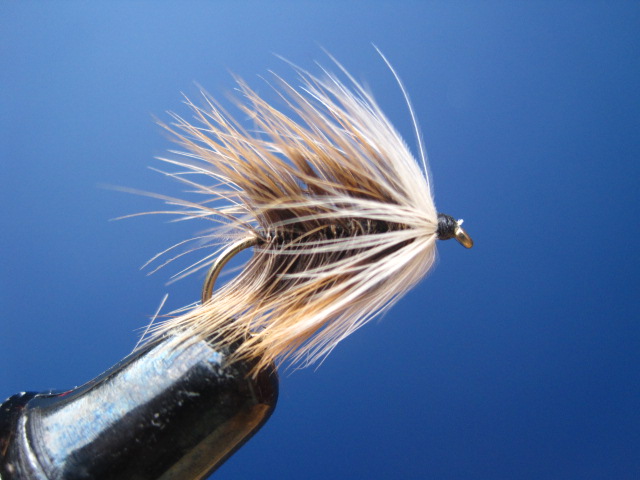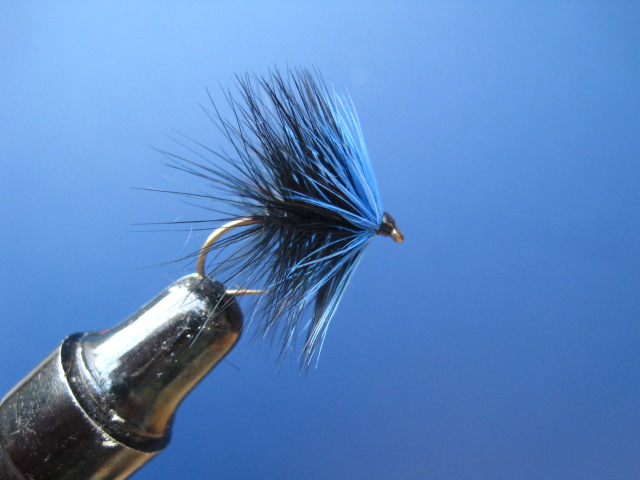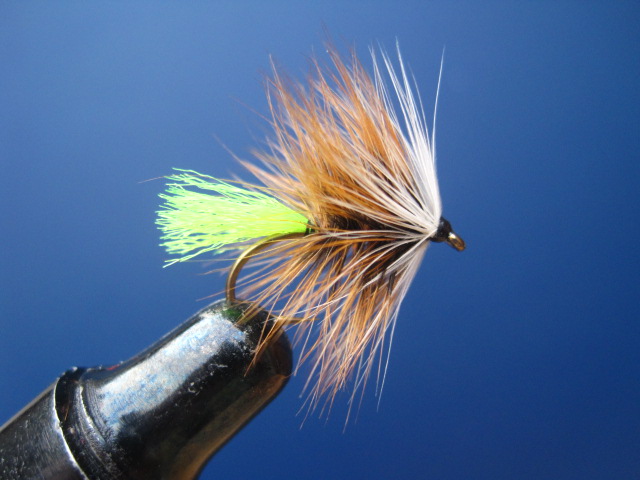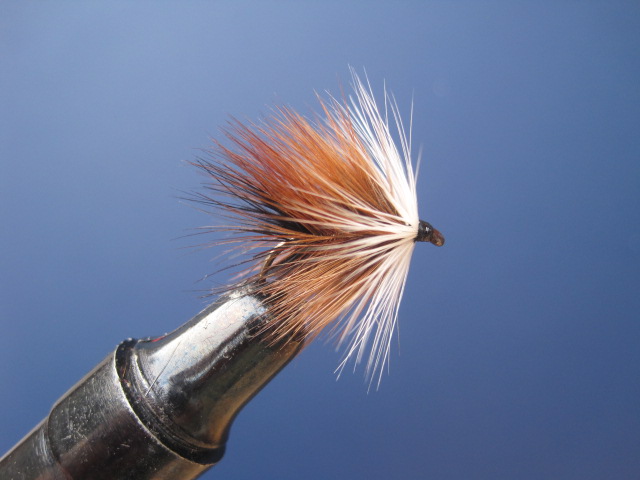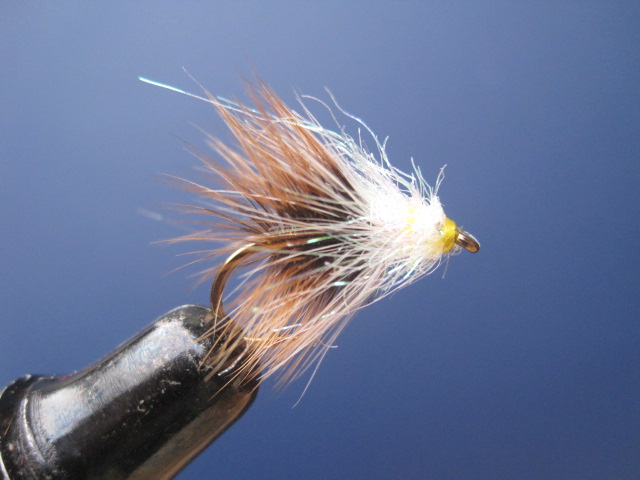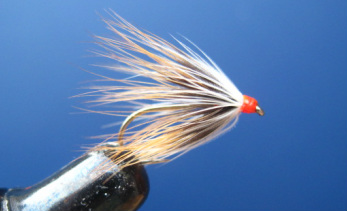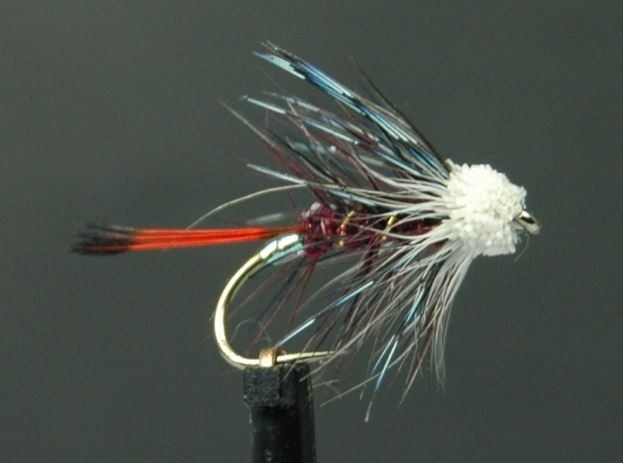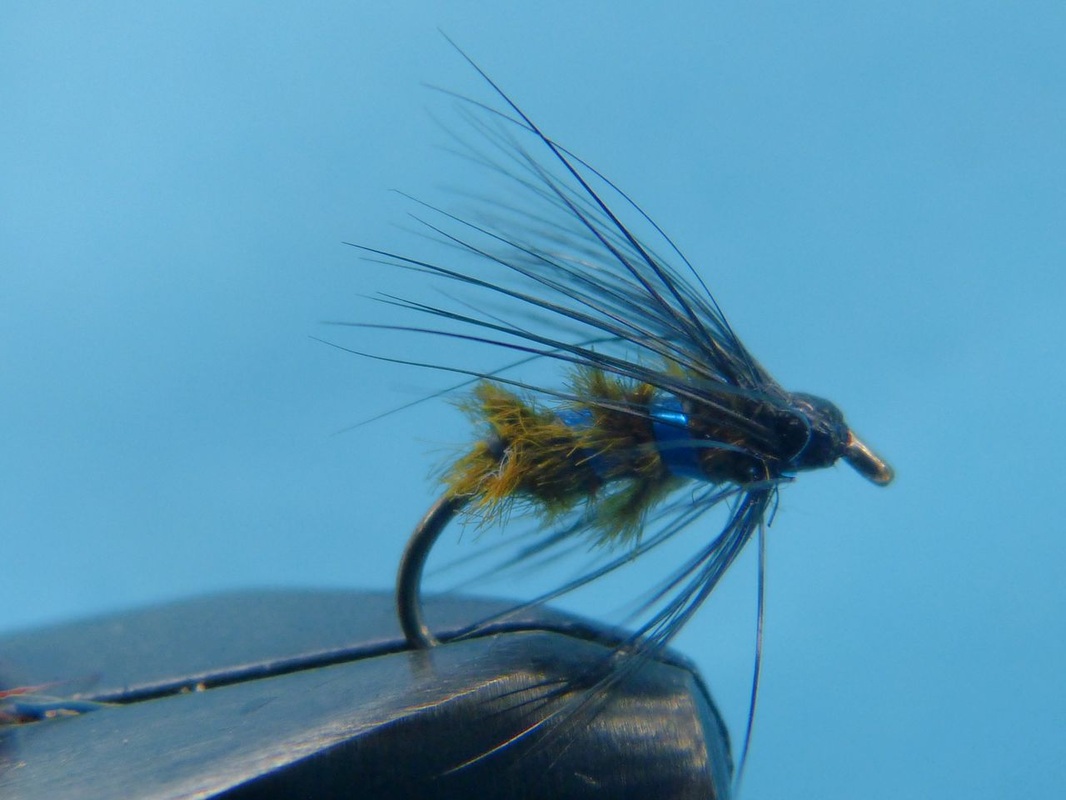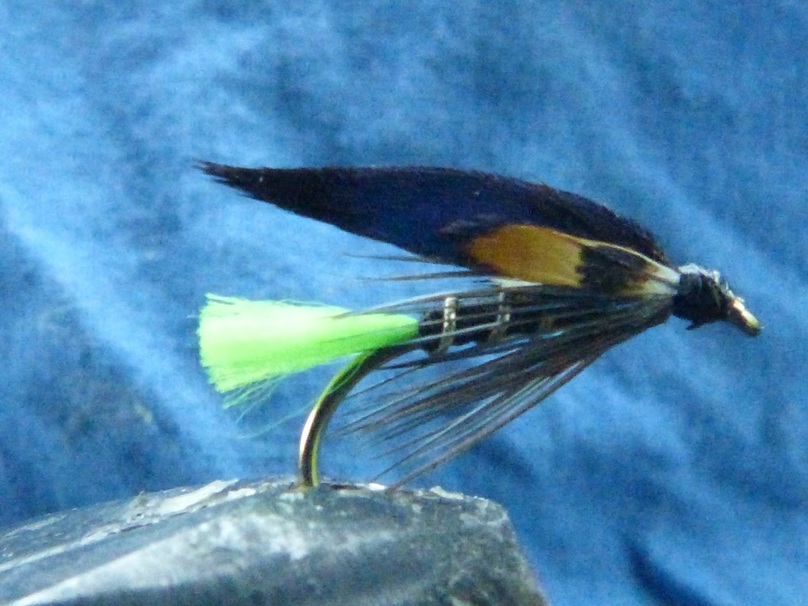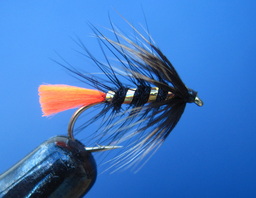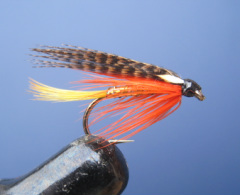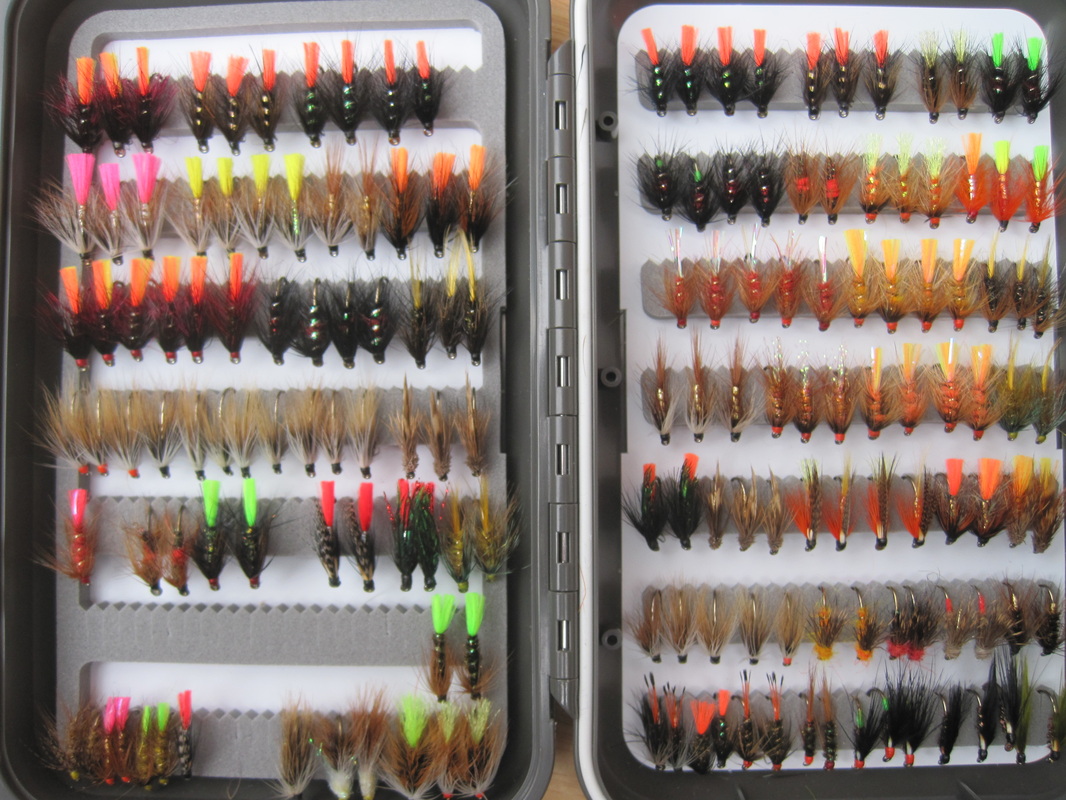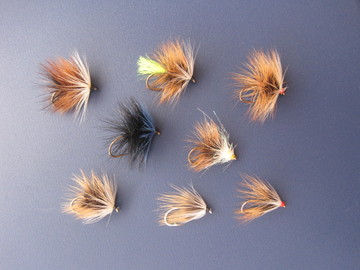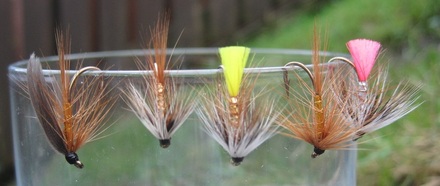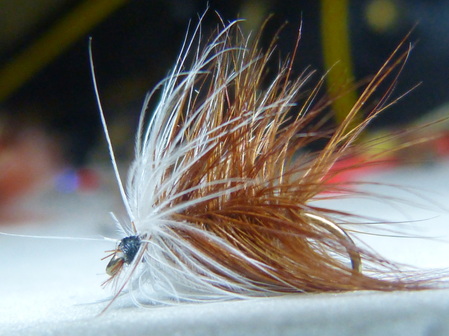
Loch Ordie
Brown Hen or Cock hackles wound up a hook shank with white hen hackles at head. There is growing debate as to who introduced the Loch Ordie pattern to Shetland. Leslie Barclay remembers his father Hector Barclay (who's original Loch Ordie is featured below) using the pattern in the 1970s and others say it was first bought to Shetland by Willie Binns over 30 years ago after he came across it in Caithsness, however it was in use in Orkney long before that and Jim Yorston from Stromness is credited with adapting it from the original dapping fly to a wet fly.
In Shetland it quickly became known as 'every ones favourite fly' being right at home in the windy far north where it is almost certainly taken for a sedge. In recent years the rise of sedgehog has led to a neglect of the loch ordie and in some quarters it seems it is completely forgotten about. However it is still an absolutely deadly deadly fly here in Shetland and many variants have evolved from the sparce anorexic ordies from Orkney, to tags tails and colour blends. Tied small and sparce it can imitate hatching midge, with an abundance of white it can fool caenis feeders, the original is a superb sedge imitator, tied on a long shank hook with not too crowded cock hackles it a superlative daddie pattern and I even saw David Pottinger catch a huge tout on a Loch Ordie fished on a Di 7 inched slowly along the bottom . In short it is a versatile fly, relatively easy and quick to dress that can cover a wide range of scenarios. Below are a selection of variants that will continue to be added to , that together are a celebration of the loch ordie and hopefully a reminder to tie an ordie to your cast when in shetland because you wont regret it.
Brown Hen or Cock hackles wound up a hook shank with white hen hackles at head. There is growing debate as to who introduced the Loch Ordie pattern to Shetland. Leslie Barclay remembers his father Hector Barclay (who's original Loch Ordie is featured below) using the pattern in the 1970s and others say it was first bought to Shetland by Willie Binns over 30 years ago after he came across it in Caithsness, however it was in use in Orkney long before that and Jim Yorston from Stromness is credited with adapting it from the original dapping fly to a wet fly.
In Shetland it quickly became known as 'every ones favourite fly' being right at home in the windy far north where it is almost certainly taken for a sedge. In recent years the rise of sedgehog has led to a neglect of the loch ordie and in some quarters it seems it is completely forgotten about. However it is still an absolutely deadly deadly fly here in Shetland and many variants have evolved from the sparce anorexic ordies from Orkney, to tags tails and colour blends. Tied small and sparce it can imitate hatching midge, with an abundance of white it can fool caenis feeders, the original is a superb sedge imitator, tied on a long shank hook with not too crowded cock hackles it a superlative daddie pattern and I even saw David Pottinger catch a huge tout on a Loch Ordie fished on a Di 7 inched slowly along the bottom . In short it is a versatile fly, relatively easy and quick to dress that can cover a wide range of scenarios. Below are a selection of variants that will continue to be added to , that together are a celebration of the loch ordie and hopefully a reminder to tie an ordie to your cast when in shetland because you wont regret it.
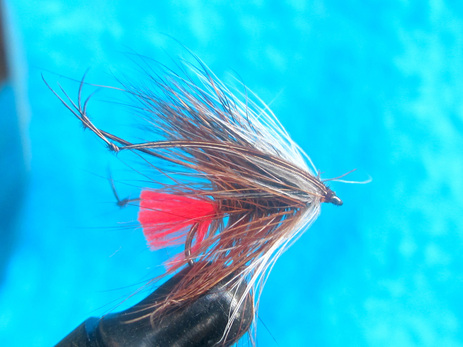
Red Tailed Leggy Loch Ordie-
Tail GB 4
Hackles Fiery Brown with white hen at front
A bit of fiery brown deer hair on top if you want extra floating qualities
knotted pheasant tail legs
Tied to provoke aggression from back end trout when daddies are on the water this fly really gets them going .
A Caithness fly called a 'Watten Warrior' utilises a similar colour scheme with the addition of a gold rib.
Tail GB 4
Hackles Fiery Brown with white hen at front
A bit of fiery brown deer hair on top if you want extra floating qualities
knotted pheasant tail legs
Tied to provoke aggression from back end trout when daddies are on the water this fly really gets them going .
A Caithness fly called a 'Watten Warrior' utilises a similar colour scheme with the addition of a gold rib.

Orange Tailed Anorexic loch Ordie- tied by Paul Bloomer
A tuft of fire orange floss at the tail of this lightly dressed ordie with legs makes this fly a killer. I usually fish it behind a sedge hog as the light fades. A few nights ago i tied one of these to my daughters cast and within a few minutes she was attached to a nice trout in the simmer dim gloaming.
The original Anoorexic Loch Ordie concept comes from the vice of top Orcadian angler Ian Hutchison.
A tuft of fire orange floss at the tail of this lightly dressed ordie with legs makes this fly a killer. I usually fish it behind a sedge hog as the light fades. A few nights ago i tied one of these to my daughters cast and within a few minutes she was attached to a nice trout in the simmer dim gloaming.
The original Anoorexic Loch Ordie concept comes from the vice of top Orcadian angler Ian Hutchison.
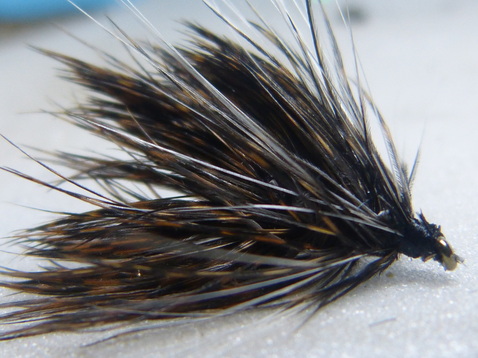
Grouse Loch Ordie
As many grouse hackles as can be tied on a hook shank with an optional white hen hackle at the front.
I do not know where this dressing originated , but on dark day in a big rolling wave this fly is deadly. In Shetland this fly was popularised by Colin Wiseman whos original pattern was more sparsely dressed then the fly in this photo and omitted the white hackle. A similar game hackled loch ordie pattern was also tied by Stan Headley, a dressing he called the 'Game Pie'.
As many grouse hackles as can be tied on a hook shank with an optional white hen hackle at the front.
I do not know where this dressing originated , but on dark day in a big rolling wave this fly is deadly. In Shetland this fly was popularised by Colin Wiseman whos original pattern was more sparsely dressed then the fly in this photo and omitted the white hackle. A similar game hackled loch ordie pattern was also tied by Stan Headley, a dressing he called the 'Game Pie'.
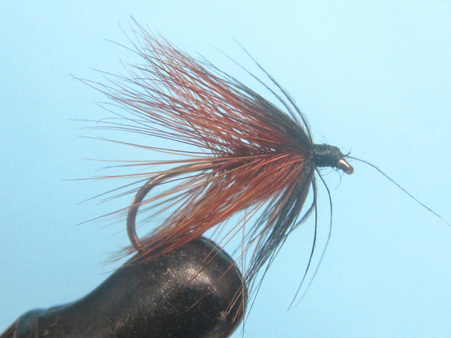
Dark Anorexic Loch ordie- Norman Irvine
Fly in picture Tied by Colin Wiseman
When small dark sedges are hatching this a superb fly
Fly in picture Tied by Colin Wiseman
When small dark sedges are hatching this a superb fly
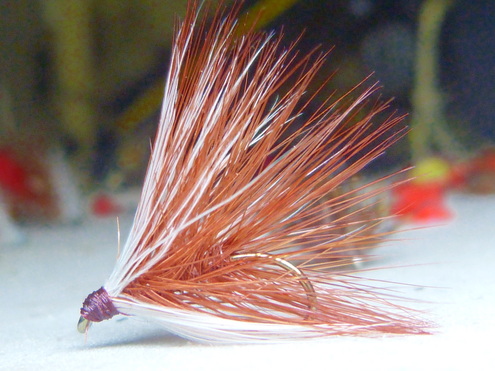
Fiery Brown Loch Ordie
Fiery Brown is a colour that is highly attractive to trout and a fiery brown ordie is a sure fire winner
Fiery Brown is a colour that is highly attractive to trout and a fiery brown ordie is a sure fire winner
Blue loch Ordie- Norman Irvine
Fly in picture tied By Colin Wiseman
On its day this can be pick of the cast according to its creator.
A few days ago Kevin Learmonth tied on a heaviliy dressed blue loch ordie which he called a 'Bad Loch Ordie' because it was so badly tied- he ginked it up and cast it to rising fish on a remote hill loch and it was taken by a two pounder as soon as it hit the water.
Fly in picture tied By Colin Wiseman
On its day this can be pick of the cast according to its creator.
A few days ago Kevin Learmonth tied on a heaviliy dressed blue loch ordie which he called a 'Bad Loch Ordie' because it was so badly tied- he ginked it up and cast it to rising fish on a remote hill loch and it was taken by a two pounder as soon as it hit the water.
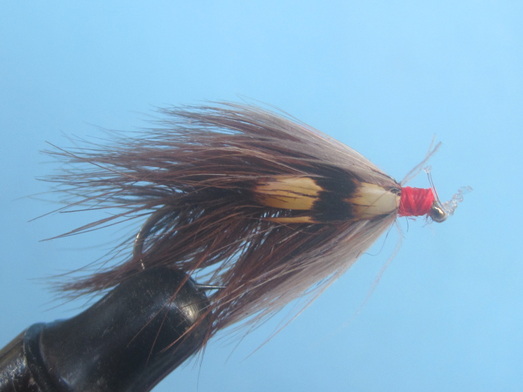
JUNGLE COCK LOCH ORDIE
David Pottinger
Hook B830 size 8
Body- as many brown hen hackles as can be palmered on the hook with a white hen hackle at head
Cheeks- large jungle cock feathers
Head- Built up with glo brite 4
David Pottinger is a legendary catcher of big wild brown trout and any fly from his box is worthy of close inspection for those anglers who like to catch big brown trout. The jungle cock cheeks, red head and highly mobile hen hackles just ooze big fish attracting power. Fish this in a big wave especially back end of the season and expect aggressive takes. The loch ordie was first bought to Shetland about 30 years ago by Willie Binns who came across it in Caithsness. It quickly became 'everyones favourite fly' and as such there are a myriad of variants of this highly versatile pattern currently in use in Shetland a selection of which will be featured here.
David Pottinger
Hook B830 size 8
Body- as many brown hen hackles as can be palmered on the hook with a white hen hackle at head
Cheeks- large jungle cock feathers
Head- Built up with glo brite 4
David Pottinger is a legendary catcher of big wild brown trout and any fly from his box is worthy of close inspection for those anglers who like to catch big brown trout. The jungle cock cheeks, red head and highly mobile hen hackles just ooze big fish attracting power. Fish this in a big wave especially back end of the season and expect aggressive takes. The loch ordie was first bought to Shetland about 30 years ago by Willie Binns who came across it in Caithsness. It quickly became 'everyones favourite fly' and as such there are a myriad of variants of this highly versatile pattern currently in use in Shetland a selection of which will be featured here.
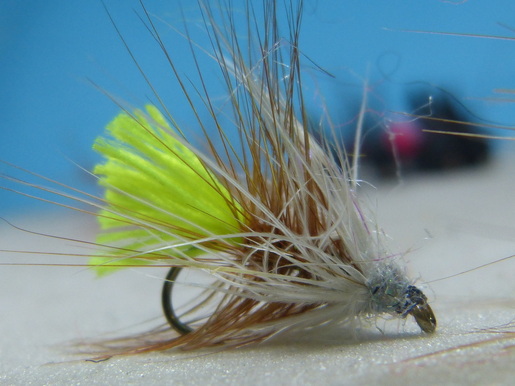
Lite Brite Loch Ordie
Tail- GB 11
Head - Pearl lite Brite dubbed over the white hen hackle
Body Hackle- Light Brown
For foul dark nights in stirred up water this loch ordie stands out well and is good for a fish
Tail- GB 11
Head - Pearl lite Brite dubbed over the white hen hackle
Body Hackle- Light Brown
For foul dark nights in stirred up water this loch ordie stands out well and is good for a fish
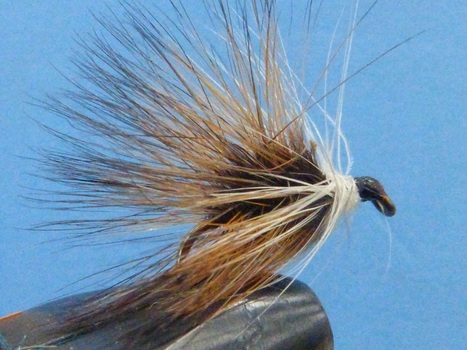
Hector Barclays Loch Ordie
Thread- Black
Body Hackle- Brown Cock hackles with the blackest centre possible
Head hackle- White Hen
In Shetland the loch ordie earned the reputation as being every ones favourite fly, and as such there are as many variants as there are anglers, with each angler adding that little extra refinement to improve what is already a very successful pattern. The late hector Barclay was a highly successful angler and the fly in this picture is several decades old .and according to his son Leslie it was never off his cast. The ingredient that gave Hector that all important confidence in the pattern was the intense black centre that emanates from within and according to Hector this is the way Loch Ordies should be tied.
Thread- Black
Body Hackle- Brown Cock hackles with the blackest centre possible
Head hackle- White Hen
In Shetland the loch ordie earned the reputation as being every ones favourite fly, and as such there are as many variants as there are anglers, with each angler adding that little extra refinement to improve what is already a very successful pattern. The late hector Barclay was a highly successful angler and the fly in this picture is several decades old .and according to his son Leslie it was never off his cast. The ingredient that gave Hector that all important confidence in the pattern was the intense black centre that emanates from within and according to Hector this is the way Loch Ordies should be tied.
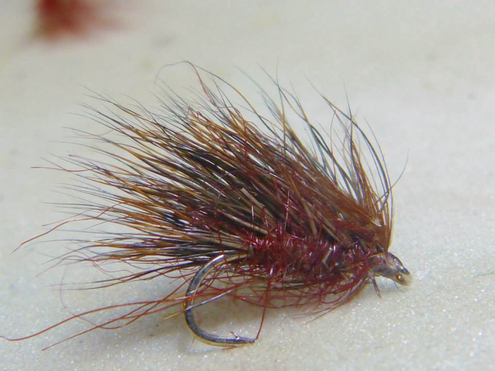
Fiery Brown Sedgehog
Hook -Kamasan B 160 size 14-8
Thread- rust brown (or to intensify the fire flourescent orange)
Wing- dark deer hair from the spine of the deer
Body- Fiery brown seal fur
Fiery brown is a very successful colour to tie sedgehogs in .
It is always worth experimenting with not just the colour of the fly, but also the tone of the fly to see what mood the fish are in according to the light or the menu, a lesson bought home after watching Davie Pottinger fish a dark loch ordie and a light loch ordie on the same cast. Up till 11 o clock the light loch ordie caught all the fish then as the light faded the dark loch ordie was the favourite . A sedge hog tied with light deer hair and hares ear or golden olive would be a good light toned alternative. If he fish favour a dark tone and the light fades more go even darker with something like a Bibio Sedgehog tied with black deer hair. The sedgehog is an essential fly and the colour combinations are endless.
Tip- Dip it in liquid floatant on the tying bench and keep in a separate box to any subsurface patterns. Experiment with the retrieve and don't be afraid to fish these flies static or slow.
Hook -Kamasan B 160 size 14-8
Thread- rust brown (or to intensify the fire flourescent orange)
Wing- dark deer hair from the spine of the deer
Body- Fiery brown seal fur
Fiery brown is a very successful colour to tie sedgehogs in .
It is always worth experimenting with not just the colour of the fly, but also the tone of the fly to see what mood the fish are in according to the light or the menu, a lesson bought home after watching Davie Pottinger fish a dark loch ordie and a light loch ordie on the same cast. Up till 11 o clock the light loch ordie caught all the fish then as the light faded the dark loch ordie was the favourite . A sedge hog tied with light deer hair and hares ear or golden olive would be a good light toned alternative. If he fish favour a dark tone and the light fades more go even darker with something like a Bibio Sedgehog tied with black deer hair. The sedgehog is an essential fly and the colour combinations are endless.
Tip- Dip it in liquid floatant on the tying bench and keep in a separate box to any subsurface patterns. Experiment with the retrieve and don't be afraid to fish these flies static or slow.
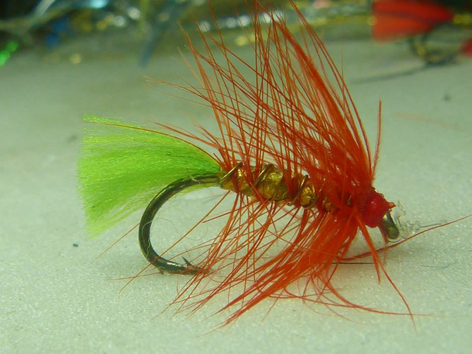
Green Tailed Oakham Orange-
tied by Paul Bloomer
Kamasan - B 175 size 10-12
Tail- Glo Brite 11/ 12 mix
Rib- Gold Wire
Body- Pearl over holographic gold
Palmered hackle- Orange Cock
Head Hackle- Orange Hen
When daphnia are on the menu this pattern can be 'death on a hook' especially on some of the West side lochs. Find the daphnia and you have found the fish is the best advice and as such experimenting with different depths and locations in the loch are advised according to conditions, as a general rule on bright days the daphnia goes deeper and on dull days /low light the daphnia is likely to be found higher in the water. Daphnia is a tiny plankton eating water flea that exists in huge blooms that can be found april onwards but reaching a peak mid summer and a percentage of the trout will move offshore to gorge on this high protein soup. Depending on species colour varies from light green to the more common Orange. Exact imitation is impossible but flies with orange or chartreuse in the dressing score well. The original Oakham orange (also deadly in Shetland)originates from the town of Oakham near Rutland water and was tied for daphnia eating rainbows on the reservoir , the dressing is a silver tinsel body with the orange hackles as above as well as a tuft of orange hackle for the tail. The roving boat or float tube angler armed with a variety of sinking lines is likely to be the most successful angler at daphnia time. Takes to this fly can be savage and it is not an exaggeration to say the rod has been ripped out of my hand several times when using his fly, one memorable occasion being a day of blazing sun I cast out this fly and started to eat my sandwiches leaving the fly static, suddenly the rod was wrenched away and catching it just in time i netted a superb fish and this happened three more times which is hard to believe with such a garish fly.
tied by Paul Bloomer
Kamasan - B 175 size 10-12
Tail- Glo Brite 11/ 12 mix
Rib- Gold Wire
Body- Pearl over holographic gold
Palmered hackle- Orange Cock
Head Hackle- Orange Hen
When daphnia are on the menu this pattern can be 'death on a hook' especially on some of the West side lochs. Find the daphnia and you have found the fish is the best advice and as such experimenting with different depths and locations in the loch are advised according to conditions, as a general rule on bright days the daphnia goes deeper and on dull days /low light the daphnia is likely to be found higher in the water. Daphnia is a tiny plankton eating water flea that exists in huge blooms that can be found april onwards but reaching a peak mid summer and a percentage of the trout will move offshore to gorge on this high protein soup. Depending on species colour varies from light green to the more common Orange. Exact imitation is impossible but flies with orange or chartreuse in the dressing score well. The original Oakham orange (also deadly in Shetland)originates from the town of Oakham near Rutland water and was tied for daphnia eating rainbows on the reservoir , the dressing is a silver tinsel body with the orange hackles as above as well as a tuft of orange hackle for the tail. The roving boat or float tube angler armed with a variety of sinking lines is likely to be the most successful angler at daphnia time. Takes to this fly can be savage and it is not an exaggeration to say the rod has been ripped out of my hand several times when using his fly, one memorable occasion being a day of blazing sun I cast out this fly and started to eat my sandwiches leaving the fly static, suddenly the rod was wrenched away and catching it just in time i netted a superb fish and this happened three more times which is hard to believe with such a garish fly.
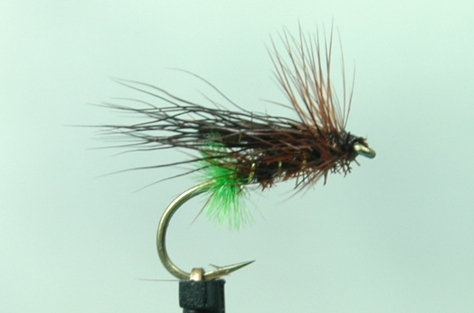
Low Rider- Tied by Graeme Callender
Tag- Green Ostrich Herl
Rib- Oval Gold Tinsel
Body- Peacock Herl
Palmered Hackle - Dark Brown Cock
Wing- Dark Brown deer Hair
Shoulder Hackle- Dark Brown Cock
When fish are taking the adult sedge spectacular sport can be had with this fly. Clip all hackles below the hook. This fly is esigned to sit in the water surface rather than on it.
Tag- Green Ostrich Herl
Rib- Oval Gold Tinsel
Body- Peacock Herl
Palmered Hackle - Dark Brown Cock
Wing- Dark Brown deer Hair
Shoulder Hackle- Dark Brown Cock
When fish are taking the adult sedge spectacular sport can be had with this fly. Clip all hackles below the hook. This fly is esigned to sit in the water surface rather than on it.
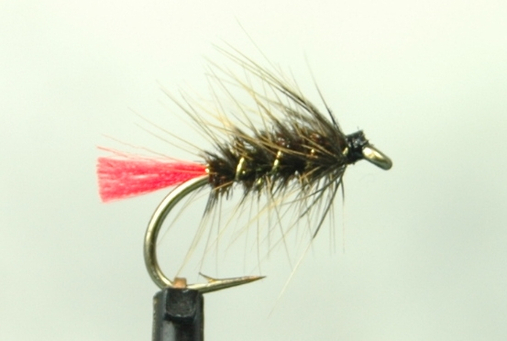
Coch Zulu- Tied by Graeme Callender
Hook- Kamasan B 175 size 12
Tail- Glo Brite 4
Rib - Gold Wire
Body- Peacock Herl
Palmered Hackle -Furnace Hen
Shoulder Hackle- Furnace Hen
When sedges are around this is an essential pattern.
Hook- Kamasan B 175 size 12
Tail- Glo Brite 4
Rib - Gold Wire
Body- Peacock Herl
Palmered Hackle -Furnace Hen
Shoulder Hackle- Furnace Hen
When sedges are around this is an essential pattern.
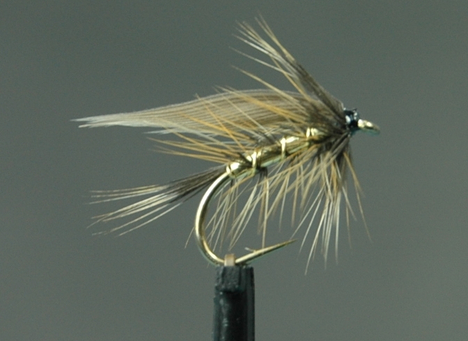
Wickhams Fancy- tied by Graeme Callender
Hook- Kamasan B 175 size 12
Tail - Furnace hen
Rib- Gold Wire
Body flat gold tinsel
Palmered Hackle -furnace hen
wing - starling
Shoulder hackle- furnace hen
When sedges are around this is an essential pattern.
Tied size 8 this is also an excellent pattern for Shetland salmon.
Hook- Kamasan B 175 size 12
Tail - Furnace hen
Rib- Gold Wire
Body flat gold tinsel
Palmered Hackle -furnace hen
wing - starling
Shoulder hackle- furnace hen
When sedges are around this is an essential pattern.
Tied size 8 this is also an excellent pattern for Shetland salmon.
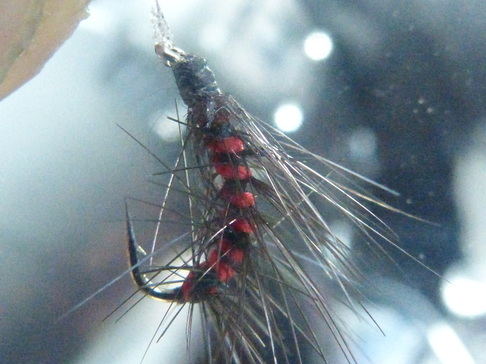
Red Ribbed Snatcher- Paul Cosgrove
Hook- Kamasan B 100 size 14-12
Thread- Black
Body- Black Seal Fur
Rib- Red thread
Hackle -Pale Black
For three years running Paul who is head of sculpture at Glasgow school of art has been visiting Shetland for a week , sleeping in his car by the side of lochs and catching some exceptionally good fish.
He travels light and brings only the patterns he has confidence in. Last week this simple snatcher caught a 3 pounder from a loch many locals have written off as well as a 4 pounder from another loch on a morning when I hardly had a bite. He fishes this on the point of a 3 fly cast with a Doobry snatcher in the middle and a sedge pattern on the bob. He sees little reason to change what he has utmost confidence in and the fine fish he has caught from some very challenging lochs on his visits are a testimony to the success of this pattern and his skill as an angler.
Hook- Kamasan B 100 size 14-12
Thread- Black
Body- Black Seal Fur
Rib- Red thread
Hackle -Pale Black
For three years running Paul who is head of sculpture at Glasgow school of art has been visiting Shetland for a week , sleeping in his car by the side of lochs and catching some exceptionally good fish.
He travels light and brings only the patterns he has confidence in. Last week this simple snatcher caught a 3 pounder from a loch many locals have written off as well as a 4 pounder from another loch on a morning when I hardly had a bite. He fishes this on the point of a 3 fly cast with a Doobry snatcher in the middle and a sedge pattern on the bob. He sees little reason to change what he has utmost confidence in and the fine fish he has caught from some very challenging lochs on his visits are a testimony to the success of this pattern and his skill as an angler.
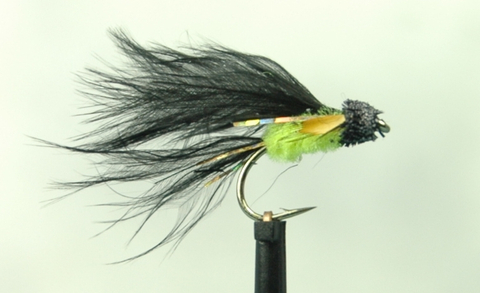
Watty's Cat- Brian Watt
Hook. Kamasan B160 #8
Tail. Brian used' Firefly'. This one is tied with Black marabou with gold holographic side flash.
Body. Cat green chenille.
Cheeks. Jungle cock.
Wing. Black marabou with gold holographic side flash.
Head. Black deer hair.
Deadly at the beginning of the season, the original had a chenille body, but modern materials can be used to good effect.
Hook. Kamasan B160 #8
Tail. Brian used' Firefly'. This one is tied with Black marabou with gold holographic side flash.
Body. Cat green chenille.
Cheeks. Jungle cock.
Wing. Black marabou with gold holographic side flash.
Head. Black deer hair.
Deadly at the beginning of the season, the original had a chenille body, but modern materials can be used to good effect.
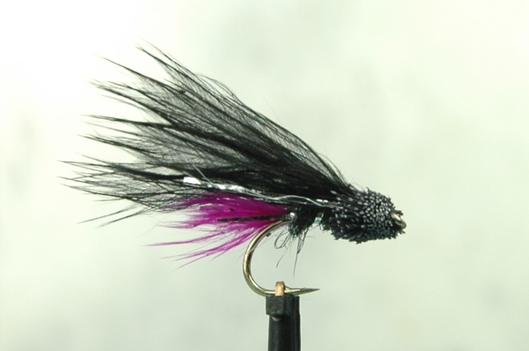
Louby Lou- Brian Watt
Tail. Magenta marabou with silver side flash.
Body. The original had a black chenille with a silver fleck through it. I have used black seals fur.
Rib. Medium flat silver tinsel.
Wing. Black marabou with silver side flash.
Head. Black deer hair
This Brian Watt pattern is over 20 years old and still catches plenty of fish today, indeed just last week Andrew Kerr caught a 6 1/4 pounder in one of the Northern Isles big fish lochs with this pattern.
Tail. Magenta marabou with silver side flash.
Body. The original had a black chenille with a silver fleck through it. I have used black seals fur.
Rib. Medium flat silver tinsel.
Wing. Black marabou with silver side flash.
Head. Black deer hair
This Brian Watt pattern is over 20 years old and still catches plenty of fish today, indeed just last week Andrew Kerr caught a 6 1/4 pounder in one of the Northern Isles big fish lochs with this pattern.
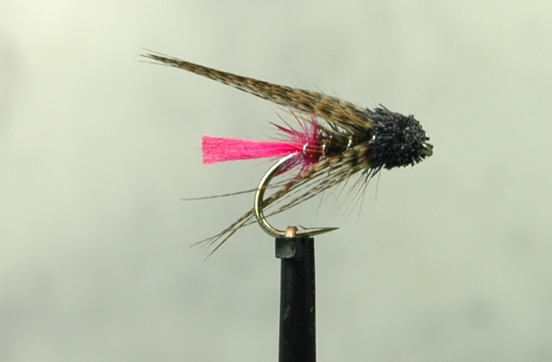
Andy Pandy- Brian Watt
Butt. Three turns of flat silver tinsel.
Tail. Magenta Glo Brite.
Tag. Magenta ostrich herl.
Rib. Silver wire.
Body. Magenta peacock herl.
Hackle. Furnace hen palmered.
Wing. Bronze mallard top and bottom, 'like an arrow'. There is a dabbler version.
Head. Black deer hair, 'shaped like a bullet'.
This Brian Watt pattern is over 20 years old and still catches plenty of fish today. Its creator is an expert angler and many describe him as 'changing the way everyone fishes in Shetland' with the tactics and flies he developed and refined.
Butt. Three turns of flat silver tinsel.
Tail. Magenta Glo Brite.
Tag. Magenta ostrich herl.
Rib. Silver wire.
Body. Magenta peacock herl.
Hackle. Furnace hen palmered.
Wing. Bronze mallard top and bottom, 'like an arrow'. There is a dabbler version.
Head. Black deer hair, 'shaped like a bullet'.
This Brian Watt pattern is over 20 years old and still catches plenty of fish today. Its creator is an expert angler and many describe him as 'changing the way everyone fishes in Shetland' with the tactics and flies he developed and refined.
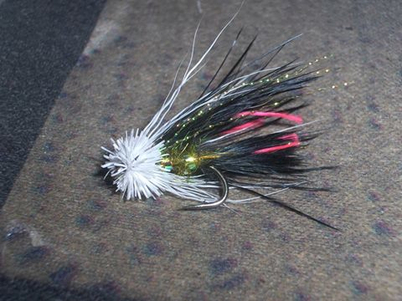
Tingski Lad- Frank Watt
B 170 size 12
Black thread
Black marabou wing and tail
3 strands of green crystal flash in wing and tai
2 single strands magenta thread in wing and tail
Olive seals fur body with mirage rib and fine copper wire over top
White muddler head
This is one of top competition anglers and Tingwall expert Franks Watts top flies for fishing on di5 - di8 lines
He say’s ‘Always fished as a bob fly apart from when I’m fishing 4 of them ‘
B 170 size 12
Black thread
Black marabou wing and tail
3 strands of green crystal flash in wing and tai
2 single strands magenta thread in wing and tail
Olive seals fur body with mirage rib and fine copper wire over top
White muddler head
This is one of top competition anglers and Tingwall expert Franks Watts top flies for fishing on di5 - di8 lines
He say’s ‘Always fished as a bob fly apart from when I’m fishing 4 of them ‘
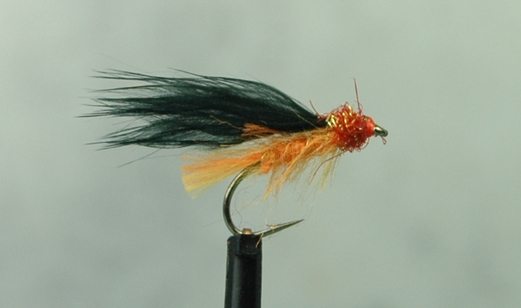
Tangerine Dream - Graeme Calender
Hook. Kamasan B170 #12
Thread. Fluo orange
Rib. Gold wire
Tail. Glo brite 7+8
Body. Dubbed Glo brite 7+8
Wing. Sooty Olive Marabou
Head. Red Glister
Orange is always a useful colour for flies in a number of situations and this is a very good fly. The Glo brite mix is dubbed on the body and brushed out to give a rough appearance. This lure is particularly effective fished as the top dropper on a fast sinking line.
Hook. Kamasan B170 #12
Thread. Fluo orange
Rib. Gold wire
Tail. Glo brite 7+8
Body. Dubbed Glo brite 7+8
Wing. Sooty Olive Marabou
Head. Red Glister
Orange is always a useful colour for flies in a number of situations and this is a very good fly. The Glo brite mix is dubbed on the body and brushed out to give a rough appearance. This lure is particularly effective fished as the top dropper on a fast sinking line.
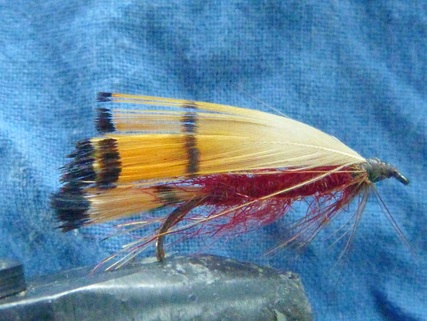
Tippet and Red
Brian Polson
Tail - GP Tippet
Body -Red Seals Fur
Rib- Gold wire
Wing -two GB tippet feathers back to back
Hook- 8- 12 long shank
In this virtual Shetland fly box we mix the long forgotten old timers with the fashionably new , alongside the all time classics. This Brian Polson sea trout pattern enjoyed great success in its day.
Another variant sports a single GB tippet wound as a head hackle. In small sizes this was also a good fly for brown trout.
Brian Polson
Tail - GP Tippet
Body -Red Seals Fur
Rib- Gold wire
Wing -two GB tippet feathers back to back
Hook- 8- 12 long shank
In this virtual Shetland fly box we mix the long forgotten old timers with the fashionably new , alongside the all time classics. This Brian Polson sea trout pattern enjoyed great success in its day.
Another variant sports a single GB tippet wound as a head hackle. In small sizes this was also a good fly for brown trout.
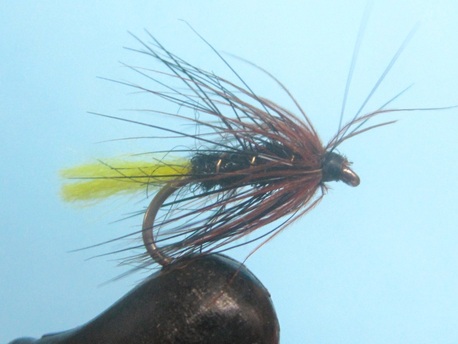
Yellow Tailed Kate Mclaren
Colin Wiseman
hook 10-14
Tail- GB 10
Body- Seal Fur
Rib- gold or silver wire
Body Hackle- Black cock Palmered
head hackle - brown hen
The influence of Colin Wiseman on a whole generation of fly tiers in Shetland cannot be underestimated, and this Kate Mclaren variant from Colin is one of
many very successful patterns to come off his vice. Lerwick tackle dealer John Hadland rates this as one of the very best flies for Shetland.
Colin Wiseman
hook 10-14
Tail- GB 10
Body- Seal Fur
Rib- gold or silver wire
Body Hackle- Black cock Palmered
head hackle - brown hen
The influence of Colin Wiseman on a whole generation of fly tiers in Shetland cannot be underestimated, and this Kate Mclaren variant from Colin is one of
many very successful patterns to come off his vice. Lerwick tackle dealer John Hadland rates this as one of the very best flies for Shetland.
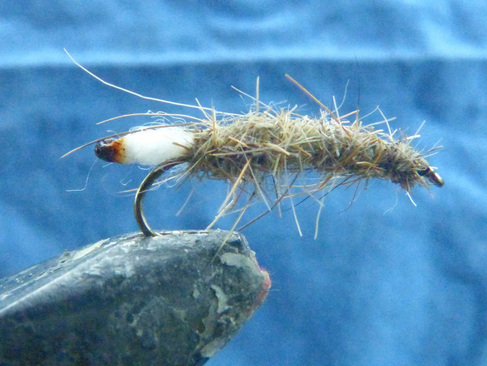
Cased Caddis
John Hadland
Hook- size 8-14 long shank- leaded
Tail- White, chartreuse or fluorescent orange wool or floss burnt at the end to give a black spot
Body- a mixture of hares ear and seal fur to blended suit colour of the cased caddis
Cased caddis are an important food source to trout in Shetland lochs. This pattern fished along rocky shores or in weed beds is an excellent imitation. Match hook size and blend of fur to the species being imitated. Look out for a more in depth page about Caddis Flies coming soon on this site in the trout food section that is currently being worked on.
John Hadland
Hook- size 8-14 long shank- leaded
Tail- White, chartreuse or fluorescent orange wool or floss burnt at the end to give a black spot
Body- a mixture of hares ear and seal fur to blended suit colour of the cased caddis
Cased caddis are an important food source to trout in Shetland lochs. This pattern fished along rocky shores or in weed beds is an excellent imitation. Match hook size and blend of fur to the species being imitated. Look out for a more in depth page about Caddis Flies coming soon on this site in the trout food section that is currently being worked on.
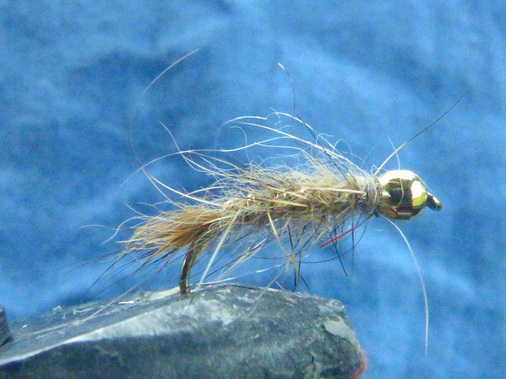
Gold Bead Hares Ear
Tied by John Hadland
Hook- 10-14 with gold bead
Tail- Fur from a hares back
Body- Fur from a hares mask mixed with squirrel tail
Rib- Oval or flat gold
In an age where fashions come and go in fly tying and new materials are bought on the market everyday , its good to be reminded of timeless classics. The gold bead hares ear was a favourite pattern of Lerwick tackle dealer John Hadland. Fished slowly it is taken with confidence by trout in a wide range of circumstances. Johns secret ingredient that accentuates that all all important shaggy look that pulsates in the water is to add chopped squirrel tail fur to the hares ear mix, the whole lot being spun into a dubbing loop. Simple ,timeless, deadly and worth having a few in the box.
Tied by John Hadland
Hook- 10-14 with gold bead
Tail- Fur from a hares back
Body- Fur from a hares mask mixed with squirrel tail
Rib- Oval or flat gold
In an age where fashions come and go in fly tying and new materials are bought on the market everyday , its good to be reminded of timeless classics. The gold bead hares ear was a favourite pattern of Lerwick tackle dealer John Hadland. Fished slowly it is taken with confidence by trout in a wide range of circumstances. Johns secret ingredient that accentuates that all all important shaggy look that pulsates in the water is to add chopped squirrel tail fur to the hares ear mix, the whole lot being spun into a dubbing loop. Simple ,timeless, deadly and worth having a few in the box.
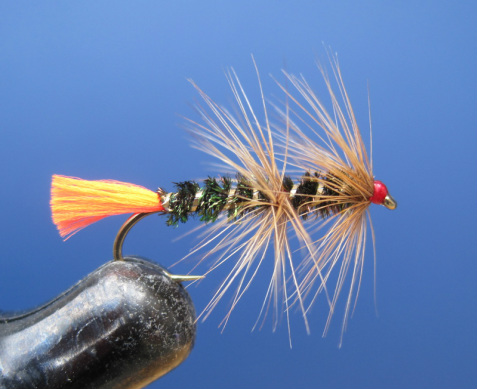
Wormfly (variant)
Hook - Kamasan B800
Silk - Red
Tail - Fluo Red or Orange floss
Rear Body - One strand Peacock herl.
Front Body - Two strands Peacock herl.
Rib - Fine oval gold.
Mid Hackle - Medium red/brown hen
Head Hackle - Medium red/brown hen tied slightly heavier.
The original Wormfly was basically a "Red Tag" tied in tandem which I would be very surprised to find in any flybox nowadays! This variant is a firm favourite of mine however. Don't be put off by its name as tied slim and sparse this is an incredibly versatile pattern which will work all through the season in a variety of different roles. It is an excellent early season pattern when fished over a shallow rocky bottom. It is a great fly for late evening work and is certainly worth a go in a big wave. However it is when fishing with a sinking line that the Wormfly really comes in to its own and where it has fished for me all over the islands. This is one of those flies that seems to be especially attractive to bigger trout and has done very well for me in this regard over the years. I was given a variant from Colin Wiseman in the early 80s which was tied with black hackles instead of red/brown. Colin swore by this pattern in Girlsa.
Hook - Kamasan B800
Silk - Red
Tail - Fluo Red or Orange floss
Rear Body - One strand Peacock herl.
Front Body - Two strands Peacock herl.
Rib - Fine oval gold.
Mid Hackle - Medium red/brown hen
Head Hackle - Medium red/brown hen tied slightly heavier.
The original Wormfly was basically a "Red Tag" tied in tandem which I would be very surprised to find in any flybox nowadays! This variant is a firm favourite of mine however. Don't be put off by its name as tied slim and sparse this is an incredibly versatile pattern which will work all through the season in a variety of different roles. It is an excellent early season pattern when fished over a shallow rocky bottom. It is a great fly for late evening work and is certainly worth a go in a big wave. However it is when fishing with a sinking line that the Wormfly really comes in to its own and where it has fished for me all over the islands. This is one of those flies that seems to be especially attractive to bigger trout and has done very well for me in this regard over the years. I was given a variant from Colin Wiseman in the early 80s which was tied with black hackles instead of red/brown. Colin swore by this pattern in Girlsa.
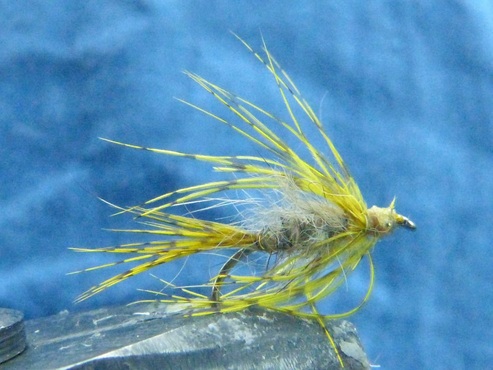
YELLOW MARCH BROWN SPIDER
Hook- size 12-10
Thread- yellow
Tail- Yellow Partridge
Body -Hares Ear
Rib - Oval Gold
Head Hackle - Yellow Partridge
One day I was fishing a peaty slightly dour west side loch with a cast of typical peat water loch patterns on and not catching much. Suddenly a car screeched up and out rushed a group of visiting anglers and almost immediately their rods were bent double with good sized trout. I thought it was a mirage so i went over to see what they were catching on and this is the fly they showed me before they screeched off again. As I sat on the shore thinking about what I had just witnessed I noticed that dung flies were being blown on the water and the trout were lined up picking them off . It was then I realised this simple pattern is a superb dung fly imitator. A few days later and i was back on the water armed with this fly and caught steadily on this pattern all day except on that on this day there was not a dung fly in sight and every fish i kept was stuffed to the brim with Sticklebacks. In short a useful fly to have in the box.
Hook- size 12-10
Thread- yellow
Tail- Yellow Partridge
Body -Hares Ear
Rib - Oval Gold
Head Hackle - Yellow Partridge
One day I was fishing a peaty slightly dour west side loch with a cast of typical peat water loch patterns on and not catching much. Suddenly a car screeched up and out rushed a group of visiting anglers and almost immediately their rods were bent double with good sized trout. I thought it was a mirage so i went over to see what they were catching on and this is the fly they showed me before they screeched off again. As I sat on the shore thinking about what I had just witnessed I noticed that dung flies were being blown on the water and the trout were lined up picking them off . It was then I realised this simple pattern is a superb dung fly imitator. A few days later and i was back on the water armed with this fly and caught steadily on this pattern all day except on that on this day there was not a dung fly in sight and every fish i kept was stuffed to the brim with Sticklebacks. In short a useful fly to have in the box.
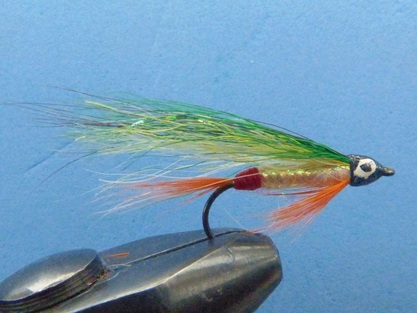
HADLANDS SEA TROUT KILLER
Hook- size 6-12 longshank preferably stainless steel
Tail - Orange or red cock hackles
Butt- Red floss
Body- Pearl mylar
Wing- White bucktail over layed with a green, yellow, olive mix of buck tail with a bit of sparkle added in.
Throat – Orange or red cock hackle
Head- Built up with black thread and a prominent eye painted on.
John Hadland was the owner of rod and Line tackle shop in Harbour Street when it was a mecca for fly fisherman, and as such john was at the centre of all fishing news and successful flies. This pattern was one of Johns favourite sea trout patterns for Shetland
Hook- size 6-12 longshank preferably stainless steel
Tail - Orange or red cock hackles
Butt- Red floss
Body- Pearl mylar
Wing- White bucktail over layed with a green, yellow, olive mix of buck tail with a bit of sparkle added in.
Throat – Orange or red cock hackle
Head- Built up with black thread and a prominent eye painted on.
John Hadland was the owner of rod and Line tackle shop in Harbour Street when it was a mecca for fly fisherman, and as such john was at the centre of all fishing news and successful flies. This pattern was one of Johns favourite sea trout patterns for Shetland
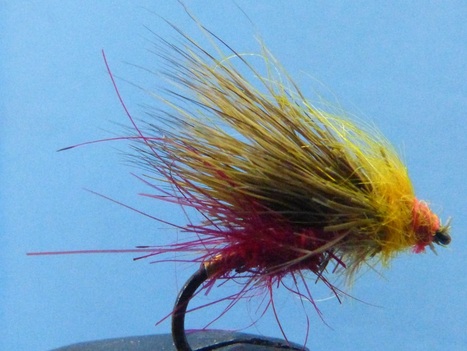
BARCLAY'S SUNBURST STINGY BEE HALF HOG
Hook – B170 size 12-10
Thread- Fluorescent Pinky Orange
Butt- flat gold
Body- 2/3 Claret Seal fur followed by 1/3 olive seal fur
Rib – As tying thread
Wing- Olive deer hair
Head- Sunburst seal fur dubbed over
"A one off fly from a one off guy!" Leslie Barclay is a popular, experienced and very successful competition angler. His "Sunburst Stingy Bee Half Hog" has been one of the main weapons in his arsenal over the last couple of seasons. It contains all the essential ingredients of a top of the water attractor and excels among surface active fish. The "BSSBHH" has consistently out fished more established patterns in this role and in a wide variety of locations.
Hook – B170 size 12-10
Thread- Fluorescent Pinky Orange
Butt- flat gold
Body- 2/3 Claret Seal fur followed by 1/3 olive seal fur
Rib – As tying thread
Wing- Olive deer hair
Head- Sunburst seal fur dubbed over
"A one off fly from a one off guy!" Leslie Barclay is a popular, experienced and very successful competition angler. His "Sunburst Stingy Bee Half Hog" has been one of the main weapons in his arsenal over the last couple of seasons. It contains all the essential ingredients of a top of the water attractor and excels among surface active fish. The "BSSBHH" has consistently out fished more established patterns in this role and in a wide variety of locations.
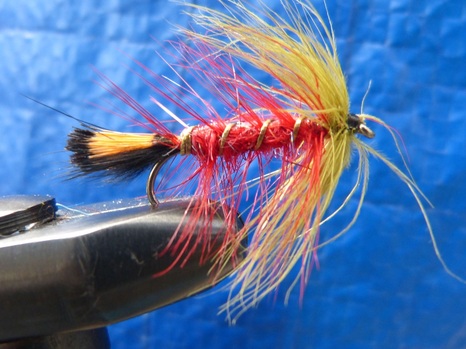
WHALSAY HAMILLS SPIDER
Variant in picture tied by Gilbert Williamson
Hook size 8 or 10 longshank
Tail—GP Tippet Over Black Squirrel hair
Body- Red wool or yellow wool
Rib- Oval gold or Silver
Body Hackle- Olive and red Cock Palmered together
Head Hackle- Olive Partridge
Here is the story of the ‘Whalsay Hamills Spider’ as told by Robert Sandison
‘The original Hamills Killer is a New Zealand fly invented by the late Bill Hamill and often fished as a lure for lake trout. The Bill Hamill original was ordered by myself from a new Zealand website about 20 years ago and the red body version was in my box for a number of years with great success both as a wet fly and ginked up as a dry fly. Personally I never once saw the original Hamills killer in any of the Shetland angler’s boxes at that time and knew of none using it. Gave a few of the originals to George Polson one of Whalsays expert anglers and big fish hunters, it lay in his box unused for a while and when he eventually gave it a try he had immediate success. Following his success with the original George gave the fly to big fish expert Brian Poleson and it was Brian that removed the wings and tied the first Whalsay Hamills Spider. After great success with the new fly but with straining eyesight when dressing flys Brian had a number of patterns dressed by a gentleman who advertised in the T &S from England 'Geoff Cherrett'. Brian also got Alan Johnson of Shetland to tie a few. The most successful of the spider varieties tied at that time proved to be the red body and hackle and both Brian and George caught numerous large fish from different Shetland lochs using that fly. The fly was named Whalsay Hamills Spider. Since that time there have been numerous variants dressed with differing degrease of success.’
Some of these variants will soon be posted in this fly box. The fly in the picture was tied by Gilbert Williamson who used red glister for the body , and an olive hen hackle for the head. The fly also has a strip of mirage across the back under the hackle and rib which acts as a flashback
As far as fishing the fly Robert Sandison says
‘Fished as a lure, but fish will often take the Hamills killer on the drop and also when fished as a heavy ginked static dry fly on the surface. To fish the Hamills Killer as a surface dry fly works for me but is in contrast to the original design as it was mainly used as a striping fly imitating small prey fish or a dragonfly nymph. In Whalsay and Shetland lochs it fishes well when the large caddis are on the water. When fished on the drop I have had several good fish cut the cast clean through with their teeth just above the fly. From the original Hamills Killer came a variant the ‘’Whalsay Hamills Spider’’ if you don't have one in your box be sure to ask the locals as this has proved to be a very productive and high catch rate fly all season’
Variant in picture tied by Gilbert Williamson
Hook size 8 or 10 longshank
Tail—GP Tippet Over Black Squirrel hair
Body- Red wool or yellow wool
Rib- Oval gold or Silver
Body Hackle- Olive and red Cock Palmered together
Head Hackle- Olive Partridge
Here is the story of the ‘Whalsay Hamills Spider’ as told by Robert Sandison
‘The original Hamills Killer is a New Zealand fly invented by the late Bill Hamill and often fished as a lure for lake trout. The Bill Hamill original was ordered by myself from a new Zealand website about 20 years ago and the red body version was in my box for a number of years with great success both as a wet fly and ginked up as a dry fly. Personally I never once saw the original Hamills killer in any of the Shetland angler’s boxes at that time and knew of none using it. Gave a few of the originals to George Polson one of Whalsays expert anglers and big fish hunters, it lay in his box unused for a while and when he eventually gave it a try he had immediate success. Following his success with the original George gave the fly to big fish expert Brian Poleson and it was Brian that removed the wings and tied the first Whalsay Hamills Spider. After great success with the new fly but with straining eyesight when dressing flys Brian had a number of patterns dressed by a gentleman who advertised in the T &S from England 'Geoff Cherrett'. Brian also got Alan Johnson of Shetland to tie a few. The most successful of the spider varieties tied at that time proved to be the red body and hackle and both Brian and George caught numerous large fish from different Shetland lochs using that fly. The fly was named Whalsay Hamills Spider. Since that time there have been numerous variants dressed with differing degrease of success.’
Some of these variants will soon be posted in this fly box. The fly in the picture was tied by Gilbert Williamson who used red glister for the body , and an olive hen hackle for the head. The fly also has a strip of mirage across the back under the hackle and rib which acts as a flashback
As far as fishing the fly Robert Sandison says
‘Fished as a lure, but fish will often take the Hamills killer on the drop and also when fished as a heavy ginked static dry fly on the surface. To fish the Hamills Killer as a surface dry fly works for me but is in contrast to the original design as it was mainly used as a striping fly imitating small prey fish or a dragonfly nymph. In Whalsay and Shetland lochs it fishes well when the large caddis are on the water. When fished on the drop I have had several good fish cut the cast clean through with their teeth just above the fly. From the original Hamills Killer came a variant the ‘’Whalsay Hamills Spider’’ if you don't have one in your box be sure to ask the locals as this has proved to be a very productive and high catch rate fly all season’
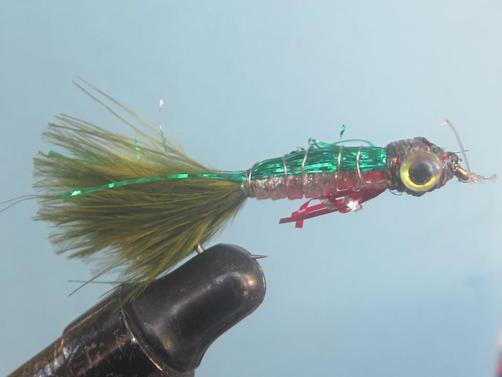
Pauls Polystickle
Hook -B830 size 8
Tail-medium olive marabou
Rib -silver wire
Underbody- holographic tinsel with gb 4 towards throat
Over body- clear glow in the dark scooby string (google it)
Back- Several strands of green holographic tinsel
Thoat- 4 strands holograhic red tinsel
Head built up with black floss and small eyes attached with uv bugbond
Richard Walker designed the original polystickle using the most up to date materials available to him at the time. This is my variation of the pattern incorporating a selection of modern materials. A bit of a pain to tie and to be honest there are simpler stickleback patterns out there but non the less it can be a very good pattern when sticklebacks are on the menu. first tie in the tail, rib , scooby string and underbody. next tie in green tinsel at head and let it hang in the opposite direction to the vice, pull the scooby string tight to make it thin then build up the body gradually releasing the tension to increase the diameter. tie it in then fold the green tinsel back and secure it with the silver rib.add the throat, build up the head and attach eyes. I like to drop this in to small hill lochs and see what grabs onto it as well as fishing it around rocky shallows . This fly also won a trout festival competition for me when cast into open water on a slow sinking line. In short worth the hassle of tying.
Hook -B830 size 8
Tail-medium olive marabou
Rib -silver wire
Underbody- holographic tinsel with gb 4 towards throat
Over body- clear glow in the dark scooby string (google it)
Back- Several strands of green holographic tinsel
Thoat- 4 strands holograhic red tinsel
Head built up with black floss and small eyes attached with uv bugbond
Richard Walker designed the original polystickle using the most up to date materials available to him at the time. This is my variation of the pattern incorporating a selection of modern materials. A bit of a pain to tie and to be honest there are simpler stickleback patterns out there but non the less it can be a very good pattern when sticklebacks are on the menu. first tie in the tail, rib , scooby string and underbody. next tie in green tinsel at head and let it hang in the opposite direction to the vice, pull the scooby string tight to make it thin then build up the body gradually releasing the tension to increase the diameter. tie it in then fold the green tinsel back and secure it with the silver rib.add the throat, build up the head and attach eyes. I like to drop this in to small hill lochs and see what grabs onto it as well as fishing it around rocky shallows . This fly also won a trout festival competition for me when cast into open water on a slow sinking line. In short worth the hassle of tying.
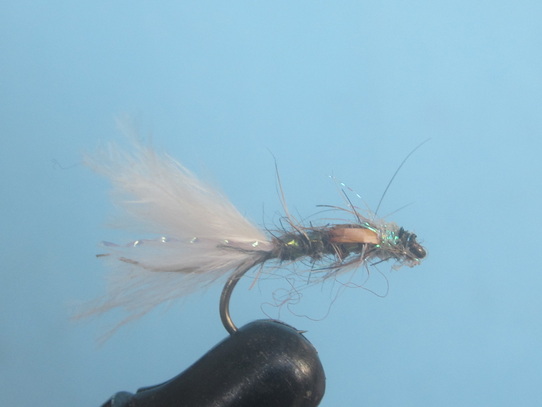
White Tailed Hares Ear
Fly in picture tied by Paul Bloomer
Hook - B170 12-14
Thread- Black
Tail- white marabou with two strands of pearl crystal flash in
Rib- pearl protected with mono
Body- Hares Ear
Cheeks- jungle cock
Head- Hares ear mixed with pearl crystal flash
When caenis are hatching exact imitation is a waste of time because a tiny fly is almost impossible for the fish to pick out amongst the thousands of naturals. However patterns with white marabou in that are cast accurately to rising trout and moved slowly in front of the fish can be the answer. This pattern slips easily through the usually calm surface film and into the trouts vision and is readily accepted. Fish as part of a two fly cast on a degreased leader . Add a sparse deer hair muddler head(do not gink up as it needs to slip just below the film to maximise the chance of the fish seeing it )and sparse white marabou wing to the above dressing and you have the perfect duo of flies for a caenis hatch.
Fly in picture tied by Paul Bloomer
Hook - B170 12-14
Thread- Black
Tail- white marabou with two strands of pearl crystal flash in
Rib- pearl protected with mono
Body- Hares Ear
Cheeks- jungle cock
Head- Hares ear mixed with pearl crystal flash
When caenis are hatching exact imitation is a waste of time because a tiny fly is almost impossible for the fish to pick out amongst the thousands of naturals. However patterns with white marabou in that are cast accurately to rising trout and moved slowly in front of the fish can be the answer. This pattern slips easily through the usually calm surface film and into the trouts vision and is readily accepted. Fish as part of a two fly cast on a degreased leader . Add a sparse deer hair muddler head(do not gink up as it needs to slip just below the film to maximise the chance of the fish seeing it )and sparse white marabou wing to the above dressing and you have the perfect duo of flies for a caenis hatch.
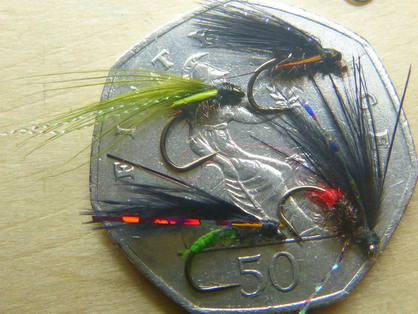
Mini Cormorants
Flies in picture tied by Paul Bloomer
Hook - B 160 size 14 and 16
Body- A few turns of peacock herl with an optional hot spot of colour
Cheeks- jungle cock or goose biot
Wing- A sparse wisp of marabou with optional bit of sparkle.
Imagine a loch boiling with rising fish during a buzzer hatch. Imagine throwing every fly in your box at them including buzzer patterns to no avail. I have been faced with this scenario many times and fumed and cursed on the bank along with everybody else. Breakthrough came when i started experimenting with the SIZE of the fly and by going as small as i could results suddenly started improving with fish taking confidently. The cormorant tied small and sparse with the dimensions of buzzer pupae in mind, can in the conditions described above be death on a hook. Cast in the vicinity of rising fish and retrieve as slow as possible. This fly has taken a great many good sized trout and as the water warms up it is very useful indeed. All the colour combinations in the picture work well but there is plenty of scope to experiment.
Flies in picture tied by Paul Bloomer
Hook - B 160 size 14 and 16
Body- A few turns of peacock herl with an optional hot spot of colour
Cheeks- jungle cock or goose biot
Wing- A sparse wisp of marabou with optional bit of sparkle.
Imagine a loch boiling with rising fish during a buzzer hatch. Imagine throwing every fly in your box at them including buzzer patterns to no avail. I have been faced with this scenario many times and fumed and cursed on the bank along with everybody else. Breakthrough came when i started experimenting with the SIZE of the fly and by going as small as i could results suddenly started improving with fish taking confidently. The cormorant tied small and sparse with the dimensions of buzzer pupae in mind, can in the conditions described above be death on a hook. Cast in the vicinity of rising fish and retrieve as slow as possible. This fly has taken a great many good sized trout and as the water warms up it is very useful indeed. All the colour combinations in the picture work well but there is plenty of scope to experiment.
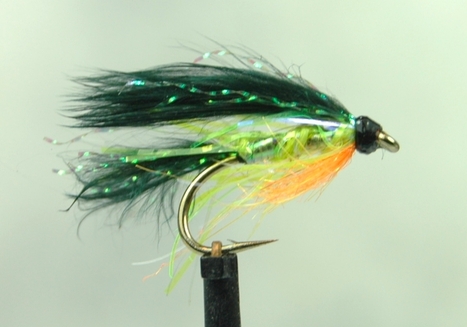
North Link Cat Varient
fly donated by Graeme Callender
Hook.Kamasan B175#11
Thread: Black
Tail: Dark green marabou over Pearl Krystal Flash
Body: Opal Mirage palmered over with Cat green Frazzle Fritz
Hackle:Blaze
Wing: Dark green marabou with a few strands of pearl Krystal Flash over.
The original North Link Cat was designed by a committee of anglers as they sat tying in the bar of the ferry south to take part in a competition. Unlike most committee decisions this one is a winner. The varient represented here differs from the original in that dark green marabou is substituted for the original black and the body uses mirage and palmered Fritz instead of the original full Fritz body. It is at its best on the point and fished with a sinking line.
fly donated by Graeme Callender
Hook.Kamasan B175#11
Thread: Black
Tail: Dark green marabou over Pearl Krystal Flash
Body: Opal Mirage palmered over with Cat green Frazzle Fritz
Hackle:Blaze
Wing: Dark green marabou with a few strands of pearl Krystal Flash over.
The original North Link Cat was designed by a committee of anglers as they sat tying in the bar of the ferry south to take part in a competition. Unlike most committee decisions this one is a winner. The varient represented here differs from the original in that dark green marabou is substituted for the original black and the body uses mirage and palmered Fritz instead of the original full Fritz body. It is at its best on the point and fished with a sinking line.
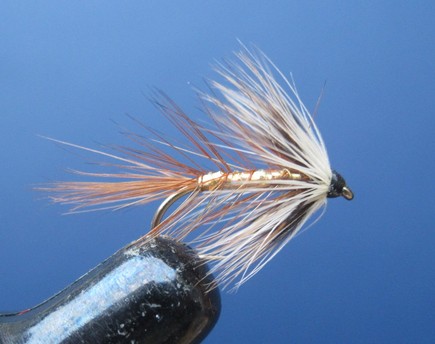
White Wickhams
Tying thread - Black.
Tail - Slim bunch of red/brown cock hackle fibres.
Body - Flat gold.
Body Hackle - Medium red/brown cock.
Rib - Gold wire.
Head Hackle - Furnace hen with white hen over.
I was first introduced to this fly when Colin Wiseman gave me one at a competition in the early 80s. Almost a cross between a Wickham's Fancy and a Loch Ordie, this was a fly that looked like it should catch fish - and did - especially on the bob in bright breezy conditions. A version of this pattern will probably be found in the boxes of most Shetland fly fishers though it is very difficult to find any records of it. It doesn't even feature in Headley's seminal "Trout & Salmon Flies of Scotland" (1997). I would imagine nowadays after the muddler and hedgehog revolution that it is hardly ever fished in it's original bushy bob fly role. However tied small and sparse it is still a very useful fly - especially on those warm summer evenings as the sun is disappearing over the hill and small white sedges are on the go.
Tying thread - Black.
Tail - Slim bunch of red/brown cock hackle fibres.
Body - Flat gold.
Body Hackle - Medium red/brown cock.
Rib - Gold wire.
Head Hackle - Furnace hen with white hen over.
I was first introduced to this fly when Colin Wiseman gave me one at a competition in the early 80s. Almost a cross between a Wickham's Fancy and a Loch Ordie, this was a fly that looked like it should catch fish - and did - especially on the bob in bright breezy conditions. A version of this pattern will probably be found in the boxes of most Shetland fly fishers though it is very difficult to find any records of it. It doesn't even feature in Headley's seminal "Trout & Salmon Flies of Scotland" (1997). I would imagine nowadays after the muddler and hedgehog revolution that it is hardly ever fished in it's original bushy bob fly role. However tied small and sparse it is still a very useful fly - especially on those warm summer evenings as the sun is disappearing over the hill and small white sedges are on the go.
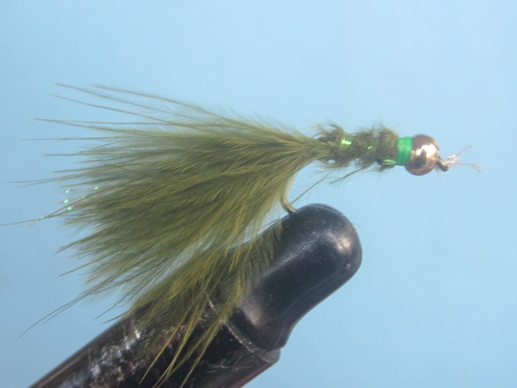
Gold Bead Damsel
Tied by Paul Bloomer
Hook - Size 10/12 with a gold bead on
Tail - Medium olive marabou with a few strands of crystal flash in
Body- Dubbed medium olive marabou
Rib- Medium Pearl with clear mono over to protect it
Thread- GB 12 built up to a prominent green hot spot
This fly is very simple to tie and is a superb catcher of big wild brown trout from fertile clear water lochs, with many 4 pound plus fish falling to its charms. The distance of Shetland from the Scottish mainland mean several aquatic species have not colonised Shetlands lochs , one of these being the damsel fly which has only been recorded in a few locations in the North Mainland and Yell. In the water this fly makes a very passable stickleback imitation and not a bad freshwater shrimp , the weighted head and highly mobile marabou tail giving a great illusion of life. This fly works best cast around weed beds and rocky shorelines varying the speed of retrieve to impart action into the fly.
Tied by Paul Bloomer
Hook - Size 10/12 with a gold bead on
Tail - Medium olive marabou with a few strands of crystal flash in
Body- Dubbed medium olive marabou
Rib- Medium Pearl with clear mono over to protect it
Thread- GB 12 built up to a prominent green hot spot
This fly is very simple to tie and is a superb catcher of big wild brown trout from fertile clear water lochs, with many 4 pound plus fish falling to its charms. The distance of Shetland from the Scottish mainland mean several aquatic species have not colonised Shetlands lochs , one of these being the damsel fly which has only been recorded in a few locations in the North Mainland and Yell. In the water this fly makes a very passable stickleback imitation and not a bad freshwater shrimp , the weighted head and highly mobile marabou tail giving a great illusion of life. This fly works best cast around weed beds and rocky shorelines varying the speed of retrieve to impart action into the fly.
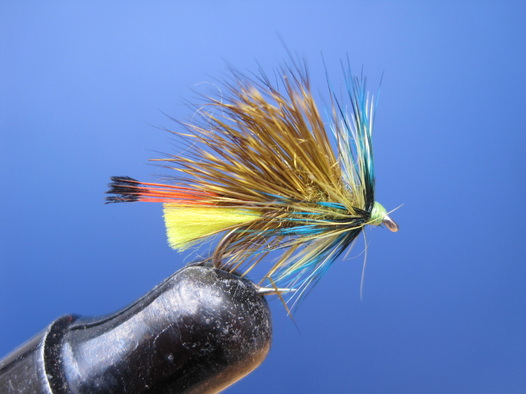
Golden Olive Bumble Hog
Donated by Barry Robertson
Tying Thread - Golden Olive.
Tail - Glo Brite floss No 10 with G.P. tippets over.
Body - Golden Olive SLF or similar.
Wing - Dyed Olive deer hair tied Hedgehog style.
Head Hackle - Blue Jay or sub.
A Davie McPhail fly kept secret in the Bonnie Isle and tied to order by the Whalsay boys. This top of the water fly contains all the lethal colours of the Golden Olive Bumble combined with the fish attracting power of the Hedgehog. Great fly for the bob position on a windy day where it will pull trout up from the depths. Some anglers like to "Gink up" the wing for maximum buoyancy and surface disrupting action.
Donated by Barry Robertson
Tying Thread - Golden Olive.
Tail - Glo Brite floss No 10 with G.P. tippets over.
Body - Golden Olive SLF or similar.
Wing - Dyed Olive deer hair tied Hedgehog style.
Head Hackle - Blue Jay or sub.
A Davie McPhail fly kept secret in the Bonnie Isle and tied to order by the Whalsay boys. This top of the water fly contains all the lethal colours of the Golden Olive Bumble combined with the fish attracting power of the Hedgehog. Great fly for the bob position on a windy day where it will pull trout up from the depths. Some anglers like to "Gink up" the wing for maximum buoyancy and surface disrupting action.
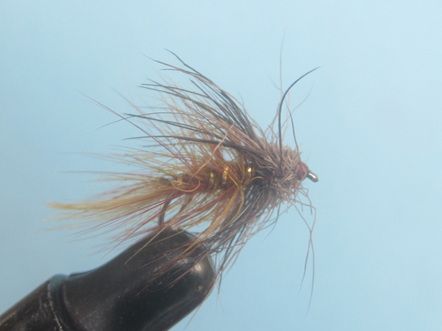
Straggly Golden Olive Bumble Muddler
fly in Picture tied by Paul Bloomer
Tail- GP topping
Body- Golden olive Seal fur
Rib- Oval Gold
Body Hackles- golden olive and fiery brown wound together (the best shade of golden olive is not the acidic bright colour of some commercial capes but a more muted colour achieved by dying a light ginger cape golden olive- Veniards hackles are very good )
Head Hackle- Blue Jay- (as long as possible for this scraggy style)
Muddler head soft light deer hair with a few tips left in
The Golden olive Bumble is the second most popular of Kingsmill Moores bumble patterns and this muddler has taken some huge catches of trout all over Shetland. Tied straggly and scruffy on purpose and roughed up with velcro this fly gives a great illusion of life when pulled through the waves. This fly can work any time , but when dung fly are on the water ,this fly ginked up provokes savage takes. One memorable misty august day on Spiggie this fly was in large part responsible for the largest ever catch of trout i have ever caught when i stopped counting after about 70 fish. However it is not just for fertile summer lochs because it won a trout festival competition on a peaty west side loch in a horizontal hail storm. In short--the golden olive bumble and its variants are essential patterns that perform well in a wide variety of conditions.
fly in Picture tied by Paul Bloomer
Tail- GP topping
Body- Golden olive Seal fur
Rib- Oval Gold
Body Hackles- golden olive and fiery brown wound together (the best shade of golden olive is not the acidic bright colour of some commercial capes but a more muted colour achieved by dying a light ginger cape golden olive- Veniards hackles are very good )
Head Hackle- Blue Jay- (as long as possible for this scraggy style)
Muddler head soft light deer hair with a few tips left in
The Golden olive Bumble is the second most popular of Kingsmill Moores bumble patterns and this muddler has taken some huge catches of trout all over Shetland. Tied straggly and scruffy on purpose and roughed up with velcro this fly gives a great illusion of life when pulled through the waves. This fly can work any time , but when dung fly are on the water ,this fly ginked up provokes savage takes. One memorable misty august day on Spiggie this fly was in large part responsible for the largest ever catch of trout i have ever caught when i stopped counting after about 70 fish. However it is not just for fertile summer lochs because it won a trout festival competition on a peaty west side loch in a horizontal hail storm. In short--the golden olive bumble and its variants are essential patterns that perform well in a wide variety of conditions.
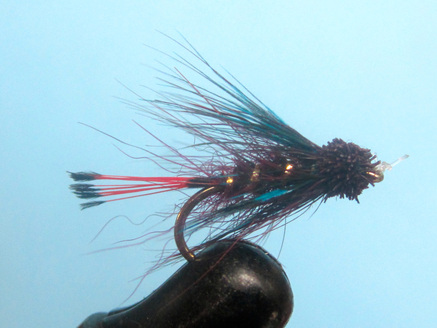
Claret Bumble Muddler
fly in picture tied by Colin Wiseman
Tail- Flourescant Orange Golden Pheasant Tippet
Body - Claret Seal Fur
Rib- Gold Oval
Body Hackle- Claret and Black Cock Palmered together
Head Hackle- partridge dyed blue
Rich claret dark deer hair muddler head
The influence of Kingsmill Moores bumble patterns cannot be underestimated and the fact that there are so many variants speaks volumes to the success of his patterns. The concept of the bumble is to wind two different coloured hackles together so that at first glance they blend together to form one colour but when viewed from below and from different angles the different colours will shine through. The Claret Bumble is possibly the most widely used in Shetland especially for peaty lochs. John Hadland the former owner of Rod and line tackle shop in harbour street describes this Colin Wiseman variant as one of the best patterns he can remember. This is an essential muddler that should be in everyones box especially for peat water lochs. Also worth trying is a similar colour scheme in a Sedgehog.
fly in picture tied by Colin Wiseman
Tail- Flourescant Orange Golden Pheasant Tippet
Body - Claret Seal Fur
Rib- Gold Oval
Body Hackle- Claret and Black Cock Palmered together
Head Hackle- partridge dyed blue
Rich claret dark deer hair muddler head
The influence of Kingsmill Moores bumble patterns cannot be underestimated and the fact that there are so many variants speaks volumes to the success of his patterns. The concept of the bumble is to wind two different coloured hackles together so that at first glance they blend together to form one colour but when viewed from below and from different angles the different colours will shine through. The Claret Bumble is possibly the most widely used in Shetland especially for peaty lochs. John Hadland the former owner of Rod and line tackle shop in harbour street describes this Colin Wiseman variant as one of the best patterns he can remember. This is an essential muddler that should be in everyones box especially for peat water lochs. Also worth trying is a similar colour scheme in a Sedgehog.
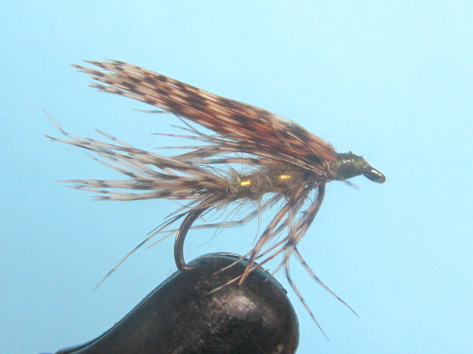
March Brown
Hook- 8-14
Tail- Brown Partridge
Body- Well mixed hares ear (older dressings to dub on a sparse under body of lemon yellow on yellow thread which turns olive when wet)
Rib- Fine Flat Gold (or Pearl works well)
Wing- Hen Pheasant
Head Hackle - Brown Partridge
One of the aims of compiling a book of the best flies for Shetland lochs is to rescue the best of the old timers from obscurity and make sure they stay with us to inspire the current and new generations of anglers. One pattern that kept coming up in conversation with some of the elder statesmen is the March Brown, indeed David Pottinger describes it as one of the very best flies he remembers particularly for fertile lochs like Benston. Suggestive of a variety of aquatic life this is surely a pattern not to forget about and experiment with. A memorable day with this pattern happened one afternoon on a west side loch, the usual gaudy coloured loch flies stopped working and I noticed olives starting to hatch, i rummaged through my box for something similar and spotted a march brown hidden away neglected, on it went and when fished slowly sub surface the action was instant.
In the book Trout Flies of Scotland , Stan Headley gives the dressing for a Palmered March Brown which uses a ginger cock hackle for the body palmer and a brown partridge for the head , describing this pattern as 'being in a league of its own'.
Hook- 8-14
Tail- Brown Partridge
Body- Well mixed hares ear (older dressings to dub on a sparse under body of lemon yellow on yellow thread which turns olive when wet)
Rib- Fine Flat Gold (or Pearl works well)
Wing- Hen Pheasant
Head Hackle - Brown Partridge
One of the aims of compiling a book of the best flies for Shetland lochs is to rescue the best of the old timers from obscurity and make sure they stay with us to inspire the current and new generations of anglers. One pattern that kept coming up in conversation with some of the elder statesmen is the March Brown, indeed David Pottinger describes it as one of the very best flies he remembers particularly for fertile lochs like Benston. Suggestive of a variety of aquatic life this is surely a pattern not to forget about and experiment with. A memorable day with this pattern happened one afternoon on a west side loch, the usual gaudy coloured loch flies stopped working and I noticed olives starting to hatch, i rummaged through my box for something similar and spotted a march brown hidden away neglected, on it went and when fished slowly sub surface the action was instant.
In the book Trout Flies of Scotland , Stan Headley gives the dressing for a Palmered March Brown which uses a ginger cock hackle for the body palmer and a brown partridge for the head , describing this pattern as 'being in a league of its own'.
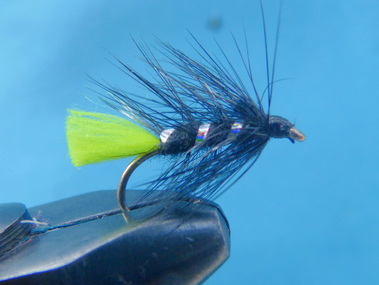
Green Zulu
Hook- 8- 14
Tail- GB 11 chartreuse or GB 12 fluorescent green - (or if you cant decide the best colour a combination of the two. Simply pull off equal lengths of 11 and 12 then keep folding them until the required thickness is achieved)
Body- Black Seal Fur
Rib- Flat Holographic Silver
Body hackle- Black Cock Palmered
Head Hackle- Black Hen
Black and green are a deadly colour combination and the green zulu fits the bill perfectly when a bushier dropper pattern is needed as opposed to the usual mini lures that incorporate this colour scheme. This fly works particularly well early season but is worth a swim any time and with any line density.
Hook- 8- 14
Tail- GB 11 chartreuse or GB 12 fluorescent green - (or if you cant decide the best colour a combination of the two. Simply pull off equal lengths of 11 and 12 then keep folding them until the required thickness is achieved)
Body- Black Seal Fur
Rib- Flat Holographic Silver
Body hackle- Black Cock Palmered
Head Hackle- Black Hen
Black and green are a deadly colour combination and the green zulu fits the bill perfectly when a bushier dropper pattern is needed as opposed to the usual mini lures that incorporate this colour scheme. This fly works particularly well early season but is worth a swim any time and with any line density.
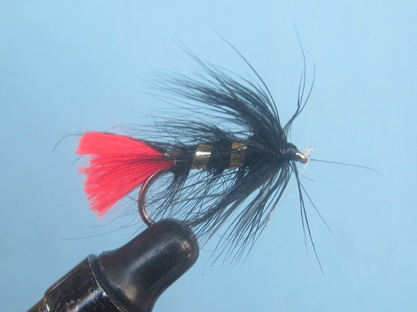
Gold Ribbed Black Zulu
Fly in the picture tied by Paul Bloomer
Hook -Size 14- to 8
Tail -Red wool or GB 4 floss
Body - Black seal fur
Rib- Flat gold tinsel
Body Hackle- Palmered black cock
Head Hackle- Black hen- (the original stated natural black with a metallic sheen)
The 300 year old zulu is a highly versatile pattern that deserves a place in every ones box. Tied small ,slim and sparse it is an acceptable (to the trout) buzzer pattern. Bigger and heavier dressed it is superb in a big wave. I once watched David Pottinger catch three stunning wild brown trout between 3 and 4 pounds from a notoriously dour loch using this pattern tied on an 8 longshank hook by drifting close to the shore and casting amongst the rocks and boulders as the evening light began to fade. One of many good variants has a magenta tail and a silver rib. The addition of a black deer hair muddler head creates a deadly muddler pattern. If you haven't got any zulus in your box tie some up now- you wont regret it.
Fly in the picture tied by Paul Bloomer
Hook -Size 14- to 8
Tail -Red wool or GB 4 floss
Body - Black seal fur
Rib- Flat gold tinsel
Body Hackle- Palmered black cock
Head Hackle- Black hen- (the original stated natural black with a metallic sheen)
The 300 year old zulu is a highly versatile pattern that deserves a place in every ones box. Tied small ,slim and sparse it is an acceptable (to the trout) buzzer pattern. Bigger and heavier dressed it is superb in a big wave. I once watched David Pottinger catch three stunning wild brown trout between 3 and 4 pounds from a notoriously dour loch using this pattern tied on an 8 longshank hook by drifting close to the shore and casting amongst the rocks and boulders as the evening light began to fade. One of many good variants has a magenta tail and a silver rib. The addition of a black deer hair muddler head creates a deadly muddler pattern. If you haven't got any zulus in your box tie some up now- you wont regret it.
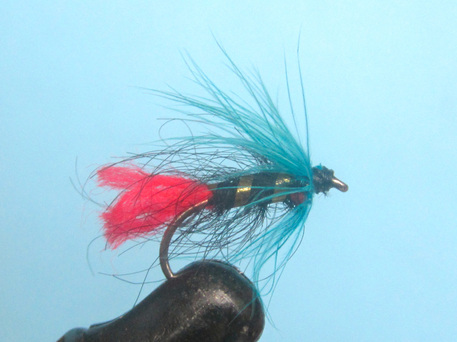
Gold Ribbed Blue Zulu
fly in this picture tied by Colin Wiseman
Hook- Size 8-14
Tail- Red wool or GB 4 floss
Rib- Flat Gold tinsel
Body - Black Seal fur
Body Hackle-Black Cock palmered-
Head Hackle- Blue Hen
The zulu can be traced back at least 300 years, and the fact that the zulu has been around so long is testimony to the continued trout catching ability of this pattern. It exists in many variations of colour combinations but the blue zulu is an all time classic that should be in everyones box. Many shy away from blue thinking it an unnatural colour but on its day it will out fish anything else. The gold ribbed version is a favourite for peaty water brown trout whilst the silver ribbed version enjoys a reputation as a great catcher of sea trout however as with all things trooty these are generalisations . The addition of a blue deer hair muddler head creates a deadly muddler pattern.
fly in this picture tied by Colin Wiseman
Hook- Size 8-14
Tail- Red wool or GB 4 floss
Rib- Flat Gold tinsel
Body - Black Seal fur
Body Hackle-Black Cock palmered-
Head Hackle- Blue Hen
The zulu can be traced back at least 300 years, and the fact that the zulu has been around so long is testimony to the continued trout catching ability of this pattern. It exists in many variations of colour combinations but the blue zulu is an all time classic that should be in everyones box. Many shy away from blue thinking it an unnatural colour but on its day it will out fish anything else. The gold ribbed version is a favourite for peaty water brown trout whilst the silver ribbed version enjoys a reputation as a great catcher of sea trout however as with all things trooty these are generalisations . The addition of a blue deer hair muddler head creates a deadly muddler pattern.
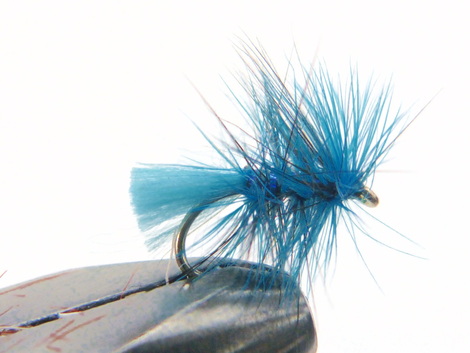
Bruiser- Variant
Andrew Pottinger
Hook b175 size 12
Tail GB blue floss
Body blue seal fur
Hackles- blue and black Cock hackle palmered
Rib- fine holographic blue tinsel
This is the fly Andrew came very close to winning the annual Benston Pottinger trophy competition with, by catching two trout on a very difficult night.
The Bruiser is one of Kingsmill Moores bumble patterns described in his superb book ‘A man may fish’ and is an underused pattern in Shetland. Andrew caused gasps of disbelief at the weigh in when he revealed the killing pattern on a night when many seasoned Benston veterans had failed to move a fish. Lesson- tie up a few Bruisers and give them a swim.
Andrew Pottinger
Hook b175 size 12
Tail GB blue floss
Body blue seal fur
Hackles- blue and black Cock hackle palmered
Rib- fine holographic blue tinsel
This is the fly Andrew came very close to winning the annual Benston Pottinger trophy competition with, by catching two trout on a very difficult night.
The Bruiser is one of Kingsmill Moores bumble patterns described in his superb book ‘A man may fish’ and is an underused pattern in Shetland. Andrew caused gasps of disbelief at the weigh in when he revealed the killing pattern on a night when many seasoned Benston veterans had failed to move a fish. Lesson- tie up a few Bruisers and give them a swim.

Red Headed Kate Mclaren Muddler
Donated by Bobby Irvine
Hook- 12-8
Tail – GP crest
Body- Black Seals fur
Rib- Gold wire
Body Hackle- Black Cock Palmered
Head- Spun Red Deer Hair
Bobby Irvine from Whalsey is known locally as a 'trout catching machine' such is his track record over years of competition angling. What is less well publicized is that Bobby is also an expert sea trout angler and the Red Headed Kate Mclaren is one of the tools of his trade when fishing for sea trout.
Donated by Bobby Irvine
Hook- 12-8
Tail – GP crest
Body- Black Seals fur
Rib- Gold wire
Body Hackle- Black Cock Palmered
Head- Spun Red Deer Hair
Bobby Irvine from Whalsey is known locally as a 'trout catching machine' such is his track record over years of competition angling. What is less well publicized is that Bobby is also an expert sea trout angler and the Red Headed Kate Mclaren is one of the tools of his trade when fishing for sea trout.
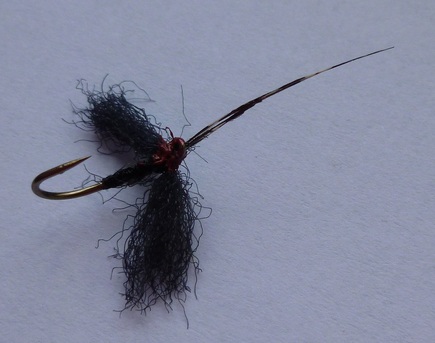
Dark Longhorn Caddis (Dry fly)
Robert Sandison
Hook. 12 14 16
Wing. Black Antron. Tied so that when fished static remains at right angles to the body of the fly.
Body. Black thread.
Head. Dark red nail varnish. To represent the distinctive eye.
Feelers. Partridge feather.
About this fly Robert says -‘Some great hatches of the dark longhorn occur in Shetland lochs and have caught some good wild trout with this coorse (rough) and simple but very effective dry fly.Very good floating capability on windy days and first-rate when fished as a single dry fly. An excellent fly to use if you want to get of the beaten track and cast in the weedy margins of the smaller Shetland lochs that are unfishable with conventional flies.
You may be surprised (as I have been) what you can lift from the depths of these unfished places! When lifting some of these better fish you won’t hook them all but at least you will have seen them and will know the potential of the water.’
Robert Sandison
Hook. 12 14 16
Wing. Black Antron. Tied so that when fished static remains at right angles to the body of the fly.
Body. Black thread.
Head. Dark red nail varnish. To represent the distinctive eye.
Feelers. Partridge feather.
About this fly Robert says -‘Some great hatches of the dark longhorn occur in Shetland lochs and have caught some good wild trout with this coorse (rough) and simple but very effective dry fly.Very good floating capability on windy days and first-rate when fished as a single dry fly. An excellent fly to use if you want to get of the beaten track and cast in the weedy margins of the smaller Shetland lochs that are unfishable with conventional flies.
You may be surprised (as I have been) what you can lift from the depths of these unfished places! When lifting some of these better fish you won’t hook them all but at least you will have seen them and will know the potential of the water.’
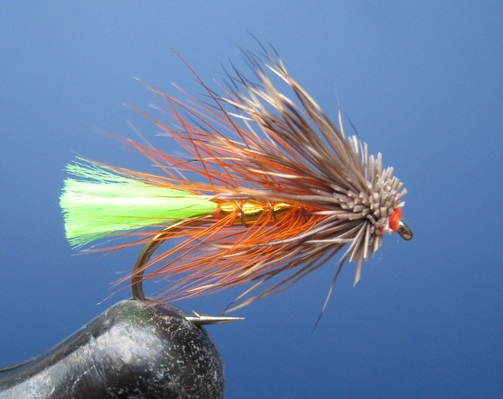
Dunkeld Muddler
Billy Reid
Hook - B175.
Tail - Glo Brite Floss No. 11 & 12 mixed.
Body - Flat Gold Lurex.
Body Hackle - Orange Cock.
Rib - Gold Wire.
Head - Deer Hair muddled.
A top fly from muddler and hedgehog specialist Billy Reid. The old adage "Bright Day, Bright Fly" could have been made up for this pattern. This is the first fly on my cast when there isn't a cloud in the sky and also really useful in coloured water. Well worth its place in any Shetland fly box.
TaT
Billy Reid
Hook - B175.
Tail - Glo Brite Floss No. 11 & 12 mixed.
Body - Flat Gold Lurex.
Body Hackle - Orange Cock.
Rib - Gold Wire.
Head - Deer Hair muddled.
A top fly from muddler and hedgehog specialist Billy Reid. The old adage "Bright Day, Bright Fly" could have been made up for this pattern. This is the first fly on my cast when there isn't a cloud in the sky and also really useful in coloured water. Well worth its place in any Shetland fly box.
TaT
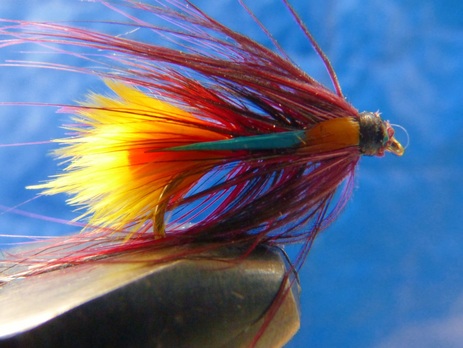
Claret Clan Chief
Terry Laurenson
Hook B 175 size 10
Tail – GB 4 with sunburst marabou over top
Body- claret seal fur
Rib - Medium silver wire
Hackle-One red and one black cock hackle palmered together
Wing – Slips of electric blue goose biots
Head hackle – straggly claret hen
Cheeks – jungle cock
A few weeks ago I found myself fishing the same loch as Terry and whilst I managed a few fish terry’s rod seemed to be constantly bent over with good sized trout. This is one of the flies that Terry uses a lot on peaty lochs.
Terry Laurenson
Hook B 175 size 10
Tail – GB 4 with sunburst marabou over top
Body- claret seal fur
Rib - Medium silver wire
Hackle-One red and one black cock hackle palmered together
Wing – Slips of electric blue goose biots
Head hackle – straggly claret hen
Cheeks – jungle cock
A few weeks ago I found myself fishing the same loch as Terry and whilst I managed a few fish terry’s rod seemed to be constantly bent over with good sized trout. This is one of the flies that Terry uses a lot on peaty lochs.
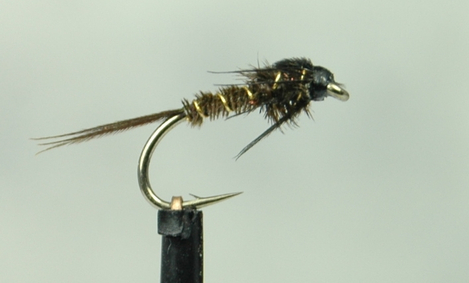
Pheasant Tail Nymph
Graeme Callender
Hook Kamasan B175.
Tail. Pheasant Tail (PT)
Body. PT
Thorax. PT
Wing cases. PT
Legs.PT
Rib. Gold wire.
This fly did very well for Graeme last year , when the fish were probably taking it for a buzzer- fish as slow as possible.
Graeme Callender
Hook Kamasan B175.
Tail. Pheasant Tail (PT)
Body. PT
Thorax. PT
Wing cases. PT
Legs.PT
Rib. Gold wire.
This fly did very well for Graeme last year , when the fish were probably taking it for a buzzer- fish as slow as possible.
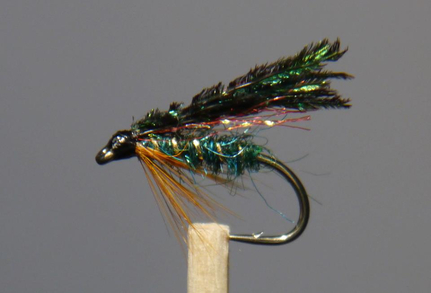
The Belmont
Thanks to Alec millar for the following information
This fly is a dressing given in the J R Tudors book "The Orkneys & Shetland" , published in 1883. Tudor was a traveller, writer & a keen angler who visited Shetland about 1880 and when in Unst one of the lochs he fished was the loch of Belmont. He writes "The loch is now strictly preserved by Major Cameron and Lord Zetland. It is however a heartbreaking loch to fish, so dour are the fish to rise. There is a fly said to be deadly at times on this water- tied as follows- Peacock bluish-green silk body, ribbed with gold tinsel, ginger red hackle for legs & four sprigs of the serrated, green sward feathers of Peacock tail and red landrail for wings"
Alan Johnson's tying of the fly has used blue/green SLF mix for the body & red twinkle instead of land rail.
Thanks to Alec millar for the following information
This fly is a dressing given in the J R Tudors book "The Orkneys & Shetland" , published in 1883. Tudor was a traveller, writer & a keen angler who visited Shetland about 1880 and when in Unst one of the lochs he fished was the loch of Belmont. He writes "The loch is now strictly preserved by Major Cameron and Lord Zetland. It is however a heartbreaking loch to fish, so dour are the fish to rise. There is a fly said to be deadly at times on this water- tied as follows- Peacock bluish-green silk body, ribbed with gold tinsel, ginger red hackle for legs & four sprigs of the serrated, green sward feathers of Peacock tail and red landrail for wings"
Alan Johnson's tying of the fly has used blue/green SLF mix for the body & red twinkle instead of land rail.
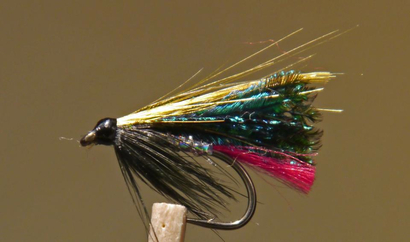
Castle Kergord
Thanks to Alec Miller for the following information.
This fly was featured in an angling book called "Where to fish in Scotland " written in 1937 by Pat Castle. He used it to fish for Salmon &Sea Trout on the Kergord Burn
Fly tied by Alan Johnson
Thanks to Alec Miller for the following information.
This fly was featured in an angling book called "Where to fish in Scotland " written in 1937 by Pat Castle. He used it to fish for Salmon &Sea Trout on the Kergord Burn
Fly tied by Alan Johnson

Castles Dunkeld
Thanks to Alec Miller for the following information.
This fly was featured in an angling book called "Where to fish in Scotland " written in 1937 by Pat Castle.
Here is Alan Johnson's version of the fly
Thanks to Alec Miller for the following information.
This fly was featured in an angling book called "Where to fish in Scotland " written in 1937 by Pat Castle.
Here is Alan Johnson's version of the fly
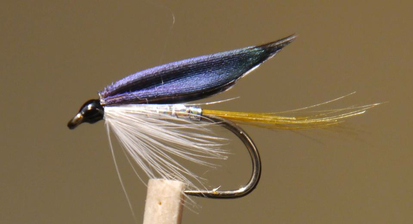
CLOUSTA BLUE-
Reinterpreted by Alan Johnson
Reinterpreted by Alan Johnson
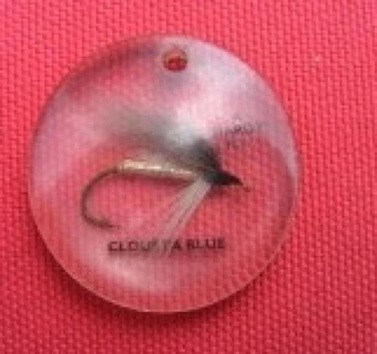
CLOUSTA BLUE
This fabled trout fly was described by Hamish Bowie in his short story- The Jellicoe
‘A hundred years ago Clousta was a thriving west-side crofting community. It was helped by a brand-new hotel and a growing reputation as a holiday resort for trout fishers. I well remember seeing a colour illustration of a new trout fly named the "Clousta Blue". The hotel was destroyed by fire in 1905 but Shetland Museum has many photographs taken inside showing prize fish labelled with details of their capture.’
Until recently lthe dressing for this fly was thought to be lost , leaving much to the imagination, however recently this cased copy appeared on ebay. It was tied commercially for hardy brothers. Apologies for the poor quality reproduction but it gives a general idea and basically the fly looks like a variant of a Wickhams Fancy with a washed out blue hackle.
This fabled trout fly was described by Hamish Bowie in his short story- The Jellicoe
‘A hundred years ago Clousta was a thriving west-side crofting community. It was helped by a brand-new hotel and a growing reputation as a holiday resort for trout fishers. I well remember seeing a colour illustration of a new trout fly named the "Clousta Blue". The hotel was destroyed by fire in 1905 but Shetland Museum has many photographs taken inside showing prize fish labelled with details of their capture.’
Until recently lthe dressing for this fly was thought to be lost , leaving much to the imagination, however recently this cased copy appeared on ebay. It was tied commercially for hardy brothers. Apologies for the poor quality reproduction but it gives a general idea and basically the fly looks like a variant of a Wickhams Fancy with a washed out blue hackle.
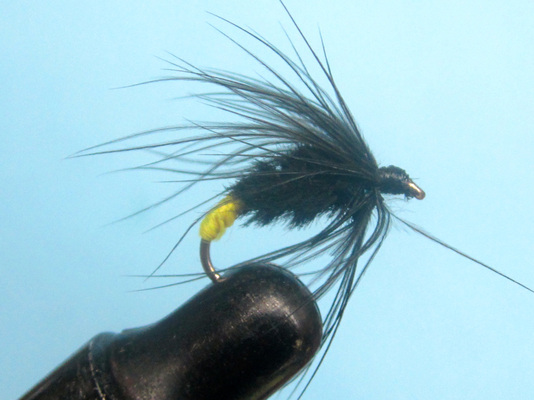
COLINS BEETLE
Colin Wiseman
Hook- B175 12-8 with lead wire wound on
Tag- Glo Brite 10
Body- Black Chenille
Head Hackle--Black hen
Colin Wiseman has a long and distinguished fly fishing career in Shetland . He is a very influential fly tier who has devoted his life to the art as well as teaching other anglers to tie flies (including myself ) , something for which I will always be grateful. As part of his fly tying lessons he left me dozens of flies to copy and learn from a selection of which will be featured here.
Colins Beetle is a simple but deadly fly suggestive of a variety creatures such as snail, aquatic beetle or cased caddis. Fish this fly with confidence especially early season when it should fished slowly around the shallow margins. This fly is as effective today as when it was first tied.
Colin Wiseman
Hook- B175 12-8 with lead wire wound on
Tag- Glo Brite 10
Body- Black Chenille
Head Hackle--Black hen
Colin Wiseman has a long and distinguished fly fishing career in Shetland . He is a very influential fly tier who has devoted his life to the art as well as teaching other anglers to tie flies (including myself ) , something for which I will always be grateful. As part of his fly tying lessons he left me dozens of flies to copy and learn from a selection of which will be featured here.
Colins Beetle is a simple but deadly fly suggestive of a variety creatures such as snail, aquatic beetle or cased caddis. Fish this fly with confidence especially early season when it should fished slowly around the shallow margins. This fly is as effective today as when it was first tied.
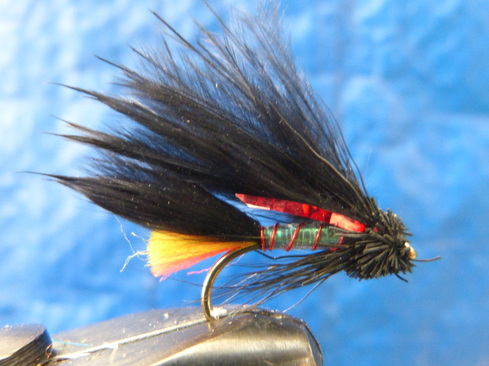
Burnylad
David John Anderson
Tail- Globrite no. 4 & 11 clan chief style with black marabou over
Body - pearl tinsel
Rib - red wire
Wing - black marabou with red tinsel strands
Head - muddled black deer hair
David John is a highly imaginative and gifted fly tier from Whalsey. The Burnylad helped him win the back of Ronas Hill competition when this fly helped him catch an excellent basket of trout from a variety of lochs. Fish it on a floater or intermediate line. Look out for more excellent flies from David John coming soon.
David John Anderson
Tail- Globrite no. 4 & 11 clan chief style with black marabou over
Body - pearl tinsel
Rib - red wire
Wing - black marabou with red tinsel strands
Head - muddled black deer hair
David John is a highly imaginative and gifted fly tier from Whalsey. The Burnylad helped him win the back of Ronas Hill competition when this fly helped him catch an excellent basket of trout from a variety of lochs. Fish it on a floater or intermediate line. Look out for more excellent flies from David John coming soon.
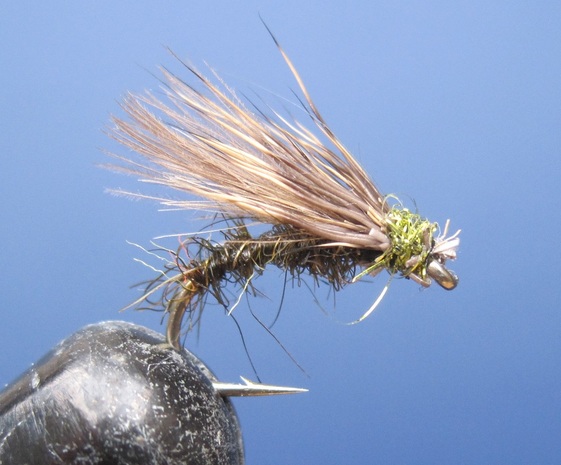
Dark Olive Emerger
Peter Laurenson
Hook - B160 (12)
Body - Dark Olive Seals Fur or similar.
Rib - Thin Brass Wire.
Underwing - Two white CDC tips.
Overwing - Natural Deer Hair - sparse.
Head - Chartreuse Lite Brite.
Olive coloured flies are always a good bet for Spiggie. No one knows this better than Spiggie master Peter Laurenson who has spent years perfecting killing patterns for this loch. This little gem inspired by a Davie McPhail fly has all the attributes of a Spiggie special and was responsible for Peter's most recent competition success.
Peter Laurenson
Hook - B160 (12)
Body - Dark Olive Seals Fur or similar.
Rib - Thin Brass Wire.
Underwing - Two white CDC tips.
Overwing - Natural Deer Hair - sparse.
Head - Chartreuse Lite Brite.
Olive coloured flies are always a good bet for Spiggie. No one knows this better than Spiggie master Peter Laurenson who has spent years perfecting killing patterns for this loch. This little gem inspired by a Davie McPhail fly has all the attributes of a Spiggie special and was responsible for Peter's most recent competition success.
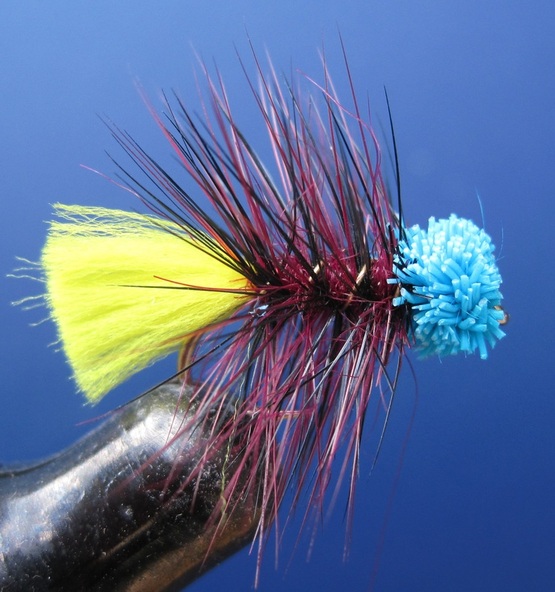
Blue Headed Muddler (aka "Liquorice Allsort") d
Donated by Barry Robertson.
Hook - B175.
Tail - Glo Brite floss No. 10. (Yellow)
Body - Claret SLF or similar.
Body Hackle - Black & Claret cock.
Rib - Gold wire.
Head - Muddled deer hair dyed blue.
All the way to Whalsay from Glasgow via Johnnie Laurenson and kept top secret in the Bonnie Isle for years. The claret and black hackles, blue surface disrupting muddler head and fluorescent yellow target tail ensures that this is an excellent fly for all our peat stained lochs. Works on all line densities. The end of the evolutionary line for the "Claret Bumble?!"
Donated by Barry Robertson.
Hook - B175.
Tail - Glo Brite floss No. 10. (Yellow)
Body - Claret SLF or similar.
Body Hackle - Black & Claret cock.
Rib - Gold wire.
Head - Muddled deer hair dyed blue.
All the way to Whalsay from Glasgow via Johnnie Laurenson and kept top secret in the Bonnie Isle for years. The claret and black hackles, blue surface disrupting muddler head and fluorescent yellow target tail ensures that this is an excellent fly for all our peat stained lochs. Works on all line densities. The end of the evolutionary line for the "Claret Bumble?!"
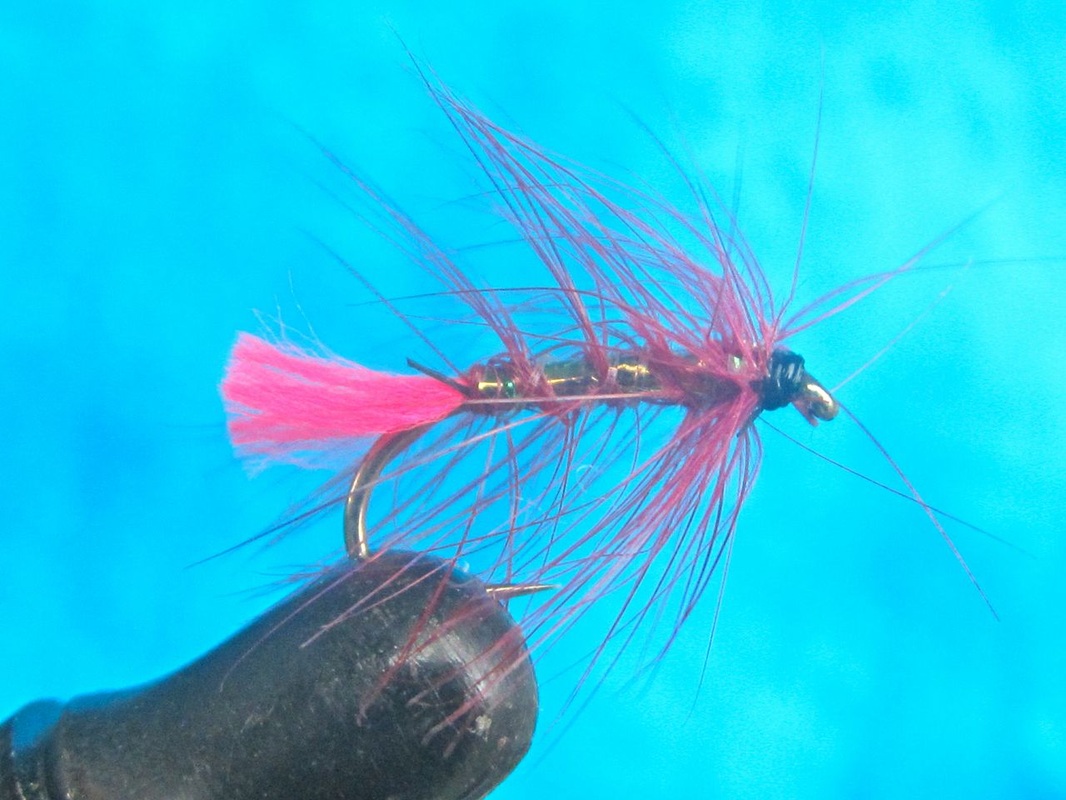
Magenta Palmer- john Hadland. John was the owner of rod and line fishing tackle shop in harbour street and is a highly skilled fly fisherman. On its day this fly can be a killer and especially in coloured water.
Hook - B175 size 10
Tail- Glo Brite 1
Body- pearl over glo brite 1 thread
rib- clear monofilament
hackle- non fluorescent magenta cock
head built up with black thread
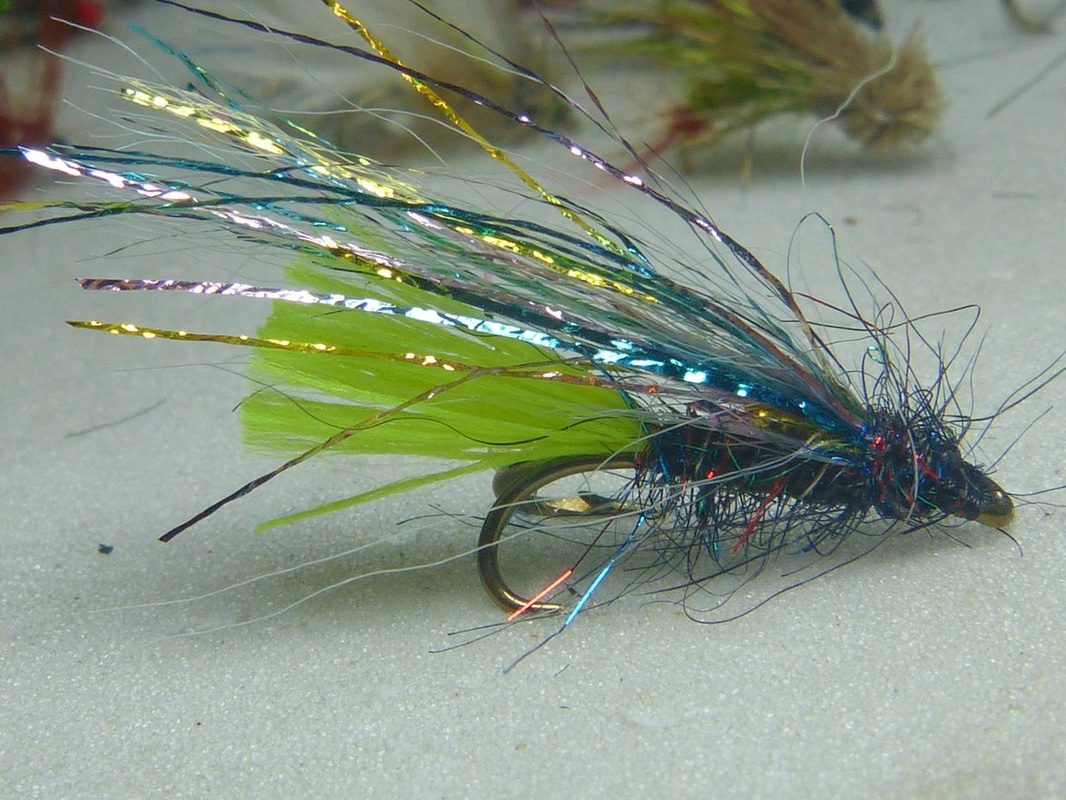
Green Tailed Sparkler- Paul Bloomer
hook- size 10 double
tail- glo brite 11 and 12 mixed
body- 75 % black seal fur mixed with 25% red,green and blue lite brite
rib -silver wire
thread- black
wing- lure flash a silvery rainbow blend of pale blues pinks gold and silver sparkle
fish on any line density on days when nothing is hatching. particularly good in low light conditions. This fly has caught a lot of big fish from lochs all over Shetland.
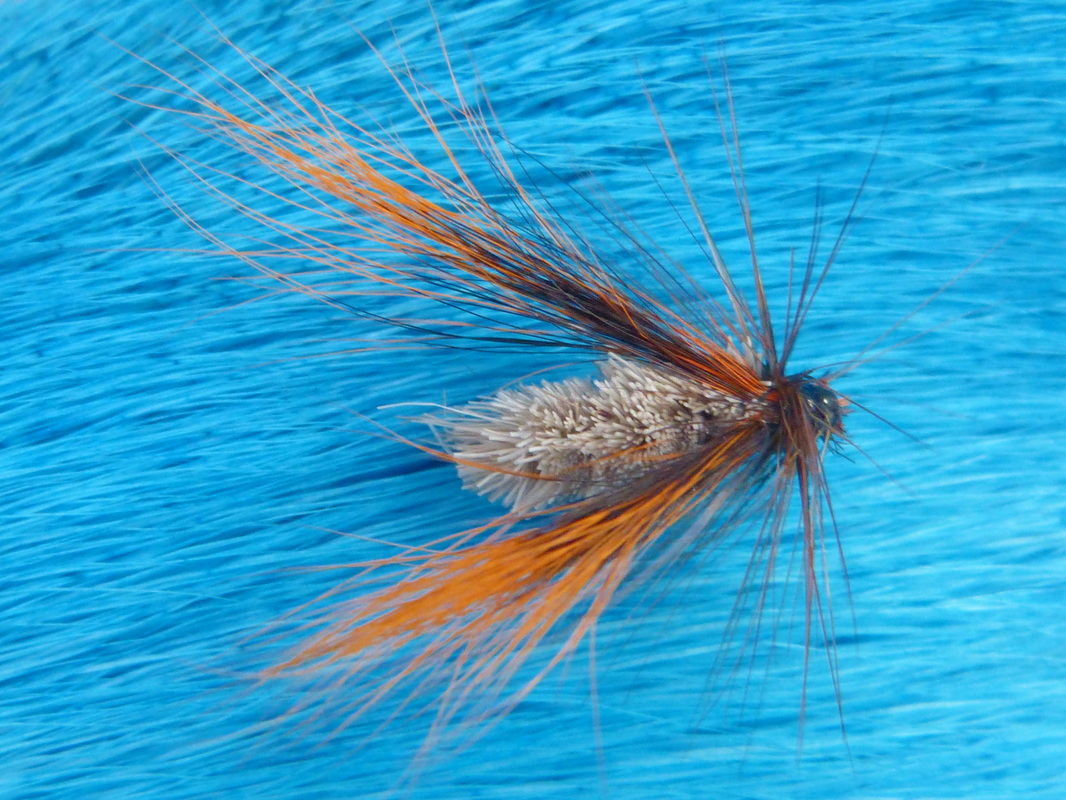
MIKES MURROUGH-Mike forbes- Photographed from above to show the spilt wings- This imitation of the great red sedge has a reputation for catching big trout - mike says ' The murrough works best from mid June to the end of the season. It represents a few of the sedges native to Shetland. It works best in a breeze on the top dropper. Tying is as follows Kamasan B175 in size 10 or sometimes even size 8 Body spun deer hair on Uni-mono fine clear tying thread. Whip finish and trim/shape deer hair. Tie in a wing of dyed orange squirrel tail with the dark roots(bleached and dyed orange works well too) Tie in and split the hair evenly forming a vee. Secure to the hook with a very small blob of UV resin. Tie in a red game cock hackle in front of the wings and whip finish.'
